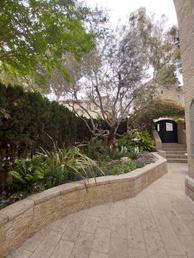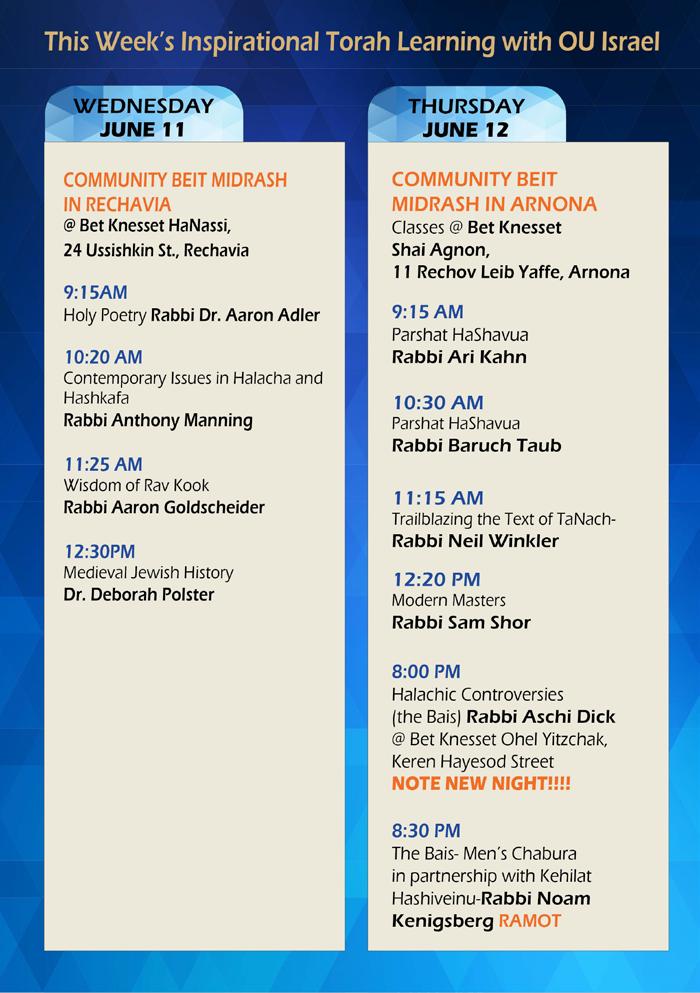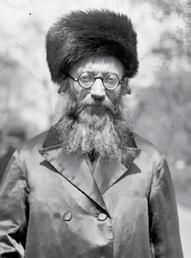














when responding to children under these circumstances.
Firstly, it’s important to give children a safe space to speak, meaning a space to express them selves in the way that is natural for them. Some children don’t have much of reaction and others will cry, show anger and frustration. They may say things that you don’t agree with or challenge you. Giving them the space to do this is crucial.
Next, when they ask questions, try to give them accurate information, answering only the questions they ask. Stay focused. It’s not necessary to elaborate or get sidetracked politics or other similar situations. Explana tions should be given in an age appropriate manner. Just like your rules are age appro priate your discussions should be as well. Having more detailed, graphic conversations is more appropriate with an 18 than a 10 year old.
Dear OU Parenting, Following the recent string of terrorist attacks, my son, 11, has become veryanxious. I, ofcourse, have also been affected by all the loss and trauma. I’m not sure how much or how little to share with him in -gen eral and specifically regarding my own emotional experience. For -exam ple, should I try not to cry and be sad around him? T.R.

Michal Silverstein, MS
Dear T.R.

It’s important to keep an eye out for both emotional and physical signs of distress. If your child looks sad, has crying spells, becomes fearful or angry or is experienc ing changes in sleeping and eating patterns, he may need extra help processing the cur rent state of events. Be aware of behavioral changes. Regarding your own emotional state, important to model emotions in front of your children. Seeing youexpress your feelings will allow your child to do the same. That

Simchat Shmuel Rabbi Sam Shor Page 48

Thank you for asking this very relevant and timely question. Adults as well as children are -over whelmed with emotions when they hear about a terrorist attack. When they become more frequent, the feeling of uncertainty and loss of control can create much anxiety. There are certain guidelines to keep in mind

In-Laws
Michal Silverstein, MS Page 66
Dear Torah Tidbits
Rabbi Avi
B’kavod Ub’yedidut; With Respect and Closeness
Rabbi Moshe Hauer
Aliya-by-Aliya Sedra Summary
Rabbi Reuven Tradburks
Rabbi Dr. Tzvi Hersh Weinreb
Rabbi Lord Jonathan Sacks zt"l
Probing the Prophets
Rabbi Nachman Winkler
Birchat Kohanim – Applicable Through the Ages
Rabbi Shalom Rosner
Rebbetzin Shira Smiles
After Yom Tov
Rabbi Judah Mischel
Beverages, Bishul Akum and Coffee Shops
Rabbi Ezra Friedman
Israel
Simchat Shmuel
Rabbi Sam Shor
The Harmony of Religion: Personalization and Unity
Rabbi Moshe Taragin
Sacred Separation
Rebbetzin Dr. Adina Shmidman
Aggadeta: Rav Kook Lights
Up A Neglected Domain
Rabbi Aaron Goldscheider
Escorting Husband Returning from Hospital on Shabbat
Rabbi Daniel Mann
In-Laws
Michal Silverstein, MS
Matchmaker Imposter Syndrome
Aleeza Ben Shalom - Shagririm Balev
After Shavuot: Carrying the Torah Forward
Sivan Rahav-Meir
Torah4Teens by Teens
Naftali & Caroline Pudell // Ovadya Galimidi
Kiddush Levana Last Opportunity to Say Kiddush Levana until: 15 Sivan/ Wed night June 10

IMAGE Photographed by Avraham Wald
We made aliya 30 years ago from South Africa. The photo was taken along the Dead Sea coastline north of Ein Gedi. The beauty of the Dead Sea coastline lies in its contrasts—harsh yet breathtaking, desolate yet so unique. It reflects the spirit of life in Israel, reminding me that beneath a rugged and unforgiving exterior, there is often a surreal and extraordinary beauty that words can scarcely capture. This is why I am so passionate about photography. It tells a story, it depicts a mood that words simply cannot describe. www.photography-israel.com
JERUSALEM
Ranges 11 days Wednesday - Shabbat
Havdala Early Candles Havdala Early Candles 8:29 6:16 7:10 8:25 6:14 7:07
Yerushalayim/Maale Adumim 8:30 6:19 7:27 8:27 6:16 7:24
Beit Shemesh/RBS
Mond/Herzliya/K.Saba
Modiin/Chashmonaim
Be’er Sheva
Petach Tikva
Ginot Shomron
Haifa / Zichron
Gush Shiloh
/ Givat Shmuel
Givat Zeev
/ Kiryat Arba
Binyamin
June 4 - 14 / 8 - 18 Sivan
Ranges 11 days Wed–Shabbat
Oct x–x / x–x Cheshvan
Aza Area (Netivot, Sderot et al) 8:29 6:17 7:28
Tzfat / Bikat HaYarden 8:30 6:17 7:26 8:27 6:14 7:23 Golan 8:33 6:20 7:28 8:30 6:17 7:25
Afula
All Times According to MyZmanim (20 mins before Sunset in most Cities; 40 mins in Yerushalyim and Petach Tikva; 30 mins in Tzfat and Haifa) Daf Yomi: Shevuos 37 BEHA’ALOTCHA
Nahariya/Maalot 8:31 6:18 7:27 8:28 6:15 7:24
Rabbeinu Tam (Jerusalem): Naso 9:00 PM • Beha’alotcha 9:03 PM
All Times According to MyZmanim (20 mins before Sunset in most Cities; 40 mins in Yerushalyim and Petach Tikva; 30 mins in Tzfat and Haifa)
Coast OU Press Synagogue/Community Services
Advocacy
OU Israel
MITCHEL R. AEDER, PRESIDENT OF THE ORTHODOX UNION Yehuda Neuberger, Chairman of the Board, Orthodox Union | Dr. Josh Penn, OU Kashrus Commission
RABBI MOSHE HAUER, EXECUTIVE VICE PRESIDENT | RABBI JOSHUA M. JOSEPH, ED.D. EXECUTIVE VICE PRESIDENT & CHIEF OPERATING OFFICER Rabbi Dr. Tzvi Hersh Weinreb, Exec. V.P. Emeritus OU KOSHER: Rabbi Menachem Genack, CEO/Rabbinic Administrator OU Kosher | Rabbi Moshe Elefant, COO/Executive Rabbinic Coordinator ISRAEL: Rabbi Yissachar Dov Krakowski, Rabbinic Administrator | Rabbi Ezra Friedman, The Gustave and Carol Jacobs Center for Kashrut Education/ Deputy Rabbinic Administrator Headquarters: 40 Rector St. 4th floor, New York, NY 10006 212-563-4000 website: www.ou.org
Editor Emeritus: Phil Chernofsky
Editor: Rabbi Aaron Goldscheider | aarong@ouisrael.org
Advertising: Ita Rochel | 02-5609125 or ttads@ouisrael.org Website: www.torahtidbits.com
Not getting enough TTs? Too many? None at all? Contact our DISTRIBUTION 050-577-2111 • ttdist@ouisrael.org
Earliest Tallit and Tefillin x:xx–x:xx Sunrise
Sof Zman Kriat Shema x:xx–x:xx
Magen Avraham x:xx–x:xx
Sof Zman Tefila x:xx-x:xx
(According to the Gra and Baal HaTanya)
Chatzot (Halachic Noon) x:xx–x:xx
Earliest Tallit and Tefillin 4:35-4:33 Sunrise 5:34-5:33 Sof Zman Kriat Shema 9:05-9:06 Magen Avraham 8:22 Sof Zman Tefila 10:16-10:17 (According to the Gra and Baal HaTanya) Chatzot (Halachic Noon) 12:37-12:39
Mincha Gedola (Earliest Mincha) x:xx–x:xx Plag Mincha x:xx–x:xx
Mincha Gedola (Earliest Mincha) 1:12-1:15 Plag Mincha 6:12-6:16
Sunset (Including Elevation) x:xx–x:xx
Sunset (Including Elevation) 7:46-7:50
Seymour J. Abrams • Orthodox Union Jerusalem World Center • Avrom Silver Jerusalem College for Adults • Wolinetz Family Shul • Makom BaLev • Birthright • Yachad • NCSY in Israel • JLIC in Israel • Camp Dror • Pearl & Harold M. Jacobs ZULA Outreach Center • The Jack Gindi Oraita Program • OU Israel Kashrut
STUART HERSHKOWITZ, PRESIDENT OU ISRAEL Zvi Sand / Yitzchak Fund: Former Presidents, OU Israel | Rabbi Emanuel Quint z”l, Senior Vice President | Prof. Meni Koslowsky, Vice President
VAAD MEMBERS:
Michael Elman | Jonathan Eltes | Yonatan Frankel | Yitzchak Fund | Daniella Hellerstein | Stuart Hershkowitz | Jeremy Lustman | Yigal Marcus | Meir Raskas | Atara Reichel | Zvi Sand | Norman Schmutter | Mark Schneider | Esther Williams
RABBI AVI BERMAN, EXECUTIVE DIRECTOR, OU ISRAEL
David Katz, CFO, OU Israel | Natan Kandler, COO, OU Israel | Chaim Pelzner, Director of Programs, OU Israel | Rabbi Sam Shor, Director, Torah Initiatives, OU Israel | Rabbi Sholom Gold zt"l, Dean, Avrom Silver Jerusalem College for Adults 7 Hartum Street, Jerusalem, 9777507 phone: (02) 560 9100 | fax: (02) 561-7432 email: office@ouisrael.org website: www.ouisrael.org
Founders and initial benefactors of the OU Israel Center: George and Ilse Falk a"h
Torah Tidbits and many of the projects of OU Israel are assisted by grants from THE JERUSALEM MUNICIPALITY

OU Israel, Torah Tidbits does not endorse the political or halachic positions of its editor, columnists or advertisers, nor guarantee the quality of advertised services or products. Nor do we endorse the kashrut of hotels, restaurants, caterers or food products that are advertised in TT (except, of course, those under OU-Israel hashgacha). Any "promises" made in ads are the sole responsibility of the advertisers and not that of OU Israel, the OU Israel Center , Torah Tidbits.

RABBI AVI BERMAN EXECUTIVE DIRECTOR, OU ISRAEL ABERMAN@OUISRAEL.ORG
Rabbi Avi Berman Executive Director, OU Israel
The English name for the book of Bamidbar - Numbers - reflects at least the first two parshiyot we are reading right now. In Parshat Bamidbar, we read about the count of almost all of Bnei Yisrael (besides the tribe of Levi), and in Parshat Naso, we start counting the families of the sons of Gershon and Merari for work in the Mishkan (tabernacle). Why did Chazal see fit to make sure these parshiyot bookend the holiday of Shavuot? What is it about counting that aligns so well with the theme of Matan Torah?
I think the answer is that the Torah is trying to help us see the importance of each person’s unique talents in Klal Yisrael. The Torah says that they should be counted, “ish al diglo,” every person at his or her flag. Everyone has their flag, their tafkid, something only they can do for Klal Yisrael and the world. This is why many of us stay up late learning Torah on Shavuot night. Each of us wants to receive our special and unique Torah on this night. Every year, I have the zechut to give shiurim all over Givat Ze’ev. It is such a beautiful experience for me to have the chance to see and experience the different Jewish communities that make up Givat Ze’ev. We have Sefardi shuls, Yemenite shuls, Dati Leumi shuls, Chareidi shuls, and even a group of Karliner chassidim who come for Shavuot to spend time with their Rebbe. I was able to see it all, walking out of a shiur I gave in one shul in English, and then to give a class at Bnei Akiva, and on the way back to my house to do a Shavuot-night oneg for younger kids.
Every shul is doing something different. Whether it’s the Sefardi shuls reading the beginning and end of every single parsha and sefer throughout Tanach as part of Tikkun Leil Shavuot, or it’s the Ashkenazi shuls, where it’s shiur after shiur with some chavrutot on the side. I love to see how Klal Yisrael’s excitement to receive the Torah has resulted in each community developing their own unique way of how they want to receive the Torah. Shavuot night has become a time that is so meaningful, so passionate, and so embracing of Hakadosh Baruch Hu and His Torah, in everyone’s unique way. I know that there are even learning programs on Shavuot night for people who consider themselves secular.
The gemara teaches us, “A person can only be expected to learn the Torah that his heart desires” (Avoda Zara 19a). The fact is that different people connect to different parts of the Torah, and different communities connect in ways unique to them. When my son Mordechai accompanied me on my tour of the Givat Ze’ev shuls on Shavuot night, I had the chance to show him how beautiful this really is. We all have one passion – to connect to HaKadosh Baruch Hu and show Him, on Shavuot night, how much we love the Torah and how much we want the Torah.
One of the purposes of the chagim is to take an idea, focus on it, and charge us to take it into the rest of the year. So, we ask ourselves: How are we taking our unique Torah learning from Shavuot and incorporating it into our lives? For example, I think that Torah Tidbits has

really become a learning tool that many people use to learn Torah every single week. Some people have even told me that the only Torah they learn all week is from Torah Tidbits. This is really a testament to the tremendous talent of the Torah Tidbits team and volunteers, who work so tirelessly to make sure Torah Tidbits is an enjoyable publication and that the Torah found in Torah Tidbits consistently inspires its readers. Let me take the opportunity to give thanks and a tremendous yasher koach to our Torah Tidbits team and volunteers for making this happen.
For those who want more Torah in your lives, and we should all want more, I encourage you to seek out Torah apps that allow people to connect, in their unique way, to the Torah. At the OU, we have developed the AllDaf app, as well as AllParsha, AllMishna, and AllHalacha. Each of these apps can be personalized to exactly what you want to study, all in one place. I believe that more than 10,000 people listen to Daf Yomi on OU’s AllDaf app. OU Israel’s Shiurim YouTube channel (youtube.com/ouisraelshiurim) provides 10+ new Shiurim of Torat Eretz Yisrael every week. Only five hundred years ago, owning books in one’s home was pretty rare. Today, not only are seforim available everywhere at relatively modest prices, but every kind is availablewith translation, without translation, with big letters, with small letters - you name it. The digital world has opened this world of learning even wider, allowing us to study Daf Yomi, or the parsha, or halacha, or the Mishna, with a teacher that speaks to us. I have tremendous hakarat hatov to the OU apps for the endless Torah that I have the merit to listen
May the Torah learned from this issue of Torah Tidbits be in loving memory of and תמשנ
Deeply missed by his wife, children, grandchildren, great-grandchildren and great-great-grandchildren
The Rebibo Family
to wherever I happen to be, whether driving, walking, even on the plane traveling to the next place to speak about what we’re doing at OU Israel. These learning apps are easy to access, and they are uplifting, inspiring, and ultimately have the power to change our entire year. Why not take our Shavuot learning and bring it further, continue it and learn more than ever before?
Beyond this, I suggest we all take upon ourselves, no matter our age, to learn more with our children, with our friends, our neighbors, our nieces, nephews, or grandchildren. Through this, we can show Hashem that Torah is not just something that we want one day a year, or something that we are happy to learn one night because everybody else is doing it, but it’s something that we want to have as part of our lives on a daily basis. I am sure that anybody who adopts these suggestions will uplift his/her life.
Wishing you all an uplifting and inspiring Shabbat,

Rabbi Avi Berman
In memory of our beloved parents, grandparents and great-grandparents

Deena & Sam Zimmerman and family
Nof Ayalon, Ramat Gan and Jerusalem



kerenmalki.org 02-567-0602 Keren

marci@bezeqint.net

















OU EXECUTIVE VICE PRESIDENT
Some time ago during one of our daily conversations, my mother shared with me how she was deeply moved by an article she had just read providing guidance to parents and educators of young people who were struggling to meet their parents’ and community’s religious and academic expectations. The writer prioritized treating the child b’kavod ub’yedidut, with respect and closeness, urging parents and educators to respect that the child truly knows what is
right and to understand that their difficult behavior is not so much rebellion as an expression of the child’s deep unhappiness.
Similar guidance was recently shared in the pages of Jewish Action (Spring 2025) by Rav Daniel Kalish of Yeshiva Ateres Shmuel of Waterbury in Durham, Connecticut, an outstanding and dedicated mechaneich of young men who is a living example of the advice he shares:
"A parent should never lose his belief in the inherent goodness of his child… to believe in the goodness of his child despite the stark differences between them… As parents we need to work on ourselves to perceive this child’s goodness and positive qualities despite the aggravation he or she might cause, often on a daily basis. And then we can start having an impact on him or her. We all make mistakes. The goal for all of us is to have an ayin tov, to see the essential goodness in all people, and especially in our children. And I’m not talking about the child’s potential, but where he or she is now."
The critical value of patient nurturing is reflected in a remarkable comment of the Midrash in our parsha. As part of the dedication ceremony of the mishkan, each of
the tribal leaders offered a bull, a ram, and a sheep. Rashi (Bamidbar 7:21) cites the Midrash associating the bull with Avraham and the meal he offered his angelic guests, the ram with Yitzchak and his replacement at the akeidah, and the sheep with Yaakov and his shepherding for Lavan. This is striking, as we well understand that in the cases of Avraham and Yitzchak the incidents with those animals aptly represented dominant and defining moments, Avraham’s chessed (generosity) and Yizchak’s gevurah (powerful self-control). But what is it about the sheep that is emblematic of Yaakov? This issue was addressed by the author of Shaarei Orah as follows:
While Avraham and Yitzchak each had a son who continued the family line and one or more who did not, Yaakov was a father of twelve sons who all remained within the fold. What Yaakov brought to the Jewish people was that powerful ability to keep the family together, to never lose a connection with any child, what our Sages consistently referred to as “mitato sheleimah”. In this, Yaakov exhibited the quality of the shepherd who tends and cares for each and every lamb, as highlighted by the beautiful words of the Rambam in describing the ideal Jewish king (Hilchos Melachim 2:6):
He should be gracious and merciful to the small and the great, involving himself in their good and welfare. He should protect the honor of even the humblest of men. When he speaks to the people as a community, he should speak gently, as it states, "Listen my brothers and my people...." Similarly, it states "If today, you will be a servant to these people...." … He should bear the nation's difficulties, burdens, complaints, and anger as
is reluctant to send Yishmael away and Yitzchak seeks reconciliation with Yish-ries Keturah; they have 6 sons. All that Avraham has goes to Yitzchak; these are sent eastward with gifts. Avraham dies at age 175; he is buried by Yitzchak and Yishmael in Ma’arat Hamachpelah. Yitzchak is blessed by G-d: he lives in Beer L’chai Roi.
The best seaview properties at the best prices and much more.


The transition from Avraham to Yitzchak is complete. While G-d has been a silent partner in this parsha, here He completes the generational transfer – He blesses Yitzchak. The Jewish people will



7th Aliya (25:12-18) The generations of Yishmael are enumerated. Yishmael dies. His descendants dwell from Egypt to Assyria. Yishmael’s story is brief. He has numerous and powerful offspring. The brevity is interested the Jewish length. echoes tions woman and began father’s that his icant the
a nurse carries an infant. The verse (Tehillim 78:71) refers to a king as a shepherd: "to pasture, Jacob, His nation." The prophets (Yeshayahu 40:11) have described the behavior of a shepherd: "He shall pasture His flock like a shepherd; He shall gather the lambs with His arm and carry them in His bosom."
BY RABBI R av, Beit Knesset
When Avraham addresses the people of Cheit, trying to “Ger V’Toshav Anochi Eimachem” (23:4) “A Stranger and This seems to be a contradiction. If one is a stranger than is no longer a stranger. What did Avraham mean? The Magid of Dubno (Jacob ben Wolf Kranz 1741-1804) this tense situation in order to, both, state his truth and be said, on the one hand, “I am a Resident’ due to G-d’s promise need your agreement to purchase a plot. In other words, Avraham “strangers”, while they understood him as saying that “they” The peace was kept, and Avraham remained true to his Shabbat Shalom
As parents, as educators, and as a community, we must be shepherds and tend to each and every one of our children and students with unconditional dedication, ensuring our continued relationship, treating them all with respect and with closeness, b’kavod ub’yedidut, and with true understanding.


ANXIETY
and our next step will be to plant a fruit tree. I never thought of myself as being the agricultural type, but the feeling of settling and planting a portion of Eretz Yisrael, has been truly euphoric. Iy”H, when we plant our tree, and eat the fruits that will grow one day, I think we will be able to truly appreciate that unique Kedusha found in the fruit of Eretz Yisrael!
It can impact your professional development, relationships, even your physical health
THERE IS A WAY OUT

Learn practical skills to feel better and take back your life
To conclude, when you buy your Tu B'shvat fruit this year, don’t search for those dried apricots and banana chips imported from Turkey. Rather, head over to the fresh produce and buy yourself some nice juicy Kedusha-filled Jaffa oranges and thank Hashem for bringing you to this land in order , imbibing that Kedusha in every bite that you take!!
TAKE THE FIRST STEP TODAY
Contact: Yonatan Sapir, MSc, Psychotherapist 0584178538 | ysapir1@gmail.com
Offices in Jerusalem and Beit Shemesh


BY RABBI CHANOCH YERES RAV, BEIT KNESSET BEIT YISRAEL, YEMIN MOSHE
“And he shall blot “it” out with the bitter water (5:23) םירמה ימ לא החמו
As part of the mystical ceremony of the “Sotah”, the verses of the curses from the Torah are inscribed on a scroll, including G-d’s name, and erased in the bitter waters. The question is asked: How can the Torah allow for the erasing of the name of G-d, seemingly a reprehensible offence?
The great Maharal from Prague (Rabbi Judah Loew 1520-1609) answers that the reason that erasing G-d’s name is sanctioned is because there is the hope that this will allay any suspicions the husband may have of his wife. There is the chance that peace will be restored between this couple and the presence of G-d will continue to remain in this marriage. The goal of this erasure is not to belittle or eradicate G-d’s name but rather the opposite, an attempt of ensuring that G-d’s presence continues to dwell in this family. The Talmud in Shabbat 10b emphasizes this idea by stating that “Peace” or “Shalom” is one of G-d’s names - very befitting for this very act. Shabbat Shalom

Aliya-by-Aliya Sedra Summary
RCA Israel Region ALIYA-BY-ALIYA
Rabbi Reuven Tradburks
RCA ISRAEL REGION
In memory of Evelyn Rivers a”h
Mother of Reuven Tradburks
While the book of Vayikra was the book of Holiness, the book of Bamidbar is the book of the national march to the Land.
They share the notion of aspiration. In Vayikra the aspiration was for Holiness, the reach beyond, the reach for the Divine. In Bamidbar, the aspiration is the Land of Israel, the march to the Land, the national aspiration to build our Jewish society in our Land.
And they share aspirations delayed, aspirations marred.
In Vayikra, the reach for the Divine, the entry to the Mikdash, was marred by Tuma. One who is Tamei, impure, needed to remove the Tuma to enter the Mikdash. A setback, but a setback that is resolved through purification. In all the aspects of Kedusha of the book of Vayikra, Kedusha being aspiration for the beyond, the setbacks have solutions, are resolvable.
And in our book of Bamidbar, the national march to the Land, the aspirational march is introduced with structure, with functions, with a census. The order of the impending march. But the aspirations are marred by the spies, by conflicts of Korach, of the failures of the chase of the Midianite women.
But these, the aspiration for Holiness and the aspiration of the Land are two entirely
different processes. Holiness, its setbacks and its resolutions, is an oscillating process. Circular. We pursue Holiness, achieve it, fall back and then regain purity. The pursuit of G-d and of Holiness is an oscillating one, moving forward, moving backward and regaining forward. The Holiness of time of the holidays is oscillating, repeating year after year. Holiness is achieved, lost and regained. That is the pattern of religious life.
History and its aspiration are an entirely different process. It does not oscillate. It moves in a linear motion. History aspires, interrupts, redirects. History is constantly changing. While man in his religious life oscillates, history moves linearly, never returning, ever changing. It is not circular, it is linear.
So, while Tuma prevents entry to the Mikdash, it has a process to remove it and allow entry. That is a circular process, returning to where we began.
The march to the Land of Israel is man in history. History never returns to where it began. History marches forward. The spies interrupt the march and while the march will continue, it is not with those people but with an entirely different group.
The Jew lives a life of oscillation, a religious life of aspiration. The Nation lives a linear life, where failures and disappointments disrupt the march, never to be regained quite the same, with the line redirected.
Jewish history of the exile was the private religious life of oscillation, the life of Vayikra,
a circular life of the pursuit of Holiness. We, the privileged generation of redemption, we are living Jewish life of Bamidbar, where National Jewish history moves forward, where the aspiration of order is marred and disrupted, but where we move in a linear fashion, ever forward, albeit in different directions.
We, the privileged Jews of redemption cannot view Jewish life only through the lens of Vayikra, as the same oscillating pursuit of Holiness with disregard for history for then we fail to grasp the monumental shift that is the book of Bamidbar, the pivot from Holiness to history, from oscillation to the linear reality of the march of history.
1ST ALIYA (BAMIDBAR 4:21-37)
A census of the family of Gershon (son of Levi) is done. The family of Gershon is responsible for transporting the textiles of the Mishkan: the curtains and the covers of the Mishkan. They are to function under the supervision of Aharon and his sons; in their case, under Itamar. The census of the family of Merari is taken. Their responsibility is the structure of the Mishkan: boards, sockets, wall braces. Their tasks are assigned by name, supervised by Itamar. The census, aged 30 – 50, of the family of Kehat is 2,750. These first 2 aliyot conclude the description of the jobs of the Leviim in managing and transporting the Mishkan. And of their census. The Leviim encamp around the Mishkan. The other 12 tribes encamp around them.
2ND ALIYA (4:38-49)
The census of Gershon, 2,630, and Merari, 3,200. The total of those who will serve and carry the Mishkan
is 8,580.
With the conclusion of the assigning of roles and of the census of the Leviim, the detailed description of the Jewish camp is complete.
The descriptions of the jobs and encampment is striking in its order. Like an army. Each group is assigned a task. Their number is recorded. There is order and structure.
But we know what will happen in this book of Bamidbar. There will be rebellions and disputes, the spies and Korach. On paper, there is order. In life, chaos.
Oh, that our national life would be so neat and tidy. You here, you here. You doing your task, you doing yours. All of us recognizing G-d in our midst. This is a lovely description of how we ought to live and how we ought to travel on into the Land of Israel.
But the book of Bamidbar is the meeting of the ideal with the real.
3RD ALIYA (5:1-10)
Command the people to send those, male or female, with Tzarat, or who are Zavim or Tamei out of the camp. The people did so. A man or woman who steals, swears denying the theft and then admits, shall repay the principal plus one fifth to the owner. If the owner has died leaving no heirs, the payment is paid to the Kohen. The Kohen’s portions fully belong to him.
While Tuma in the book of Vayikra is a setback that is beyond our control, in the march to the land of Israel, the setbacks are all self-induced. Stealing and lying to cover it up.
Stealing and lying are paradigmatic failures of people trying to live together in society. But self-induced. There are times when we deal with our fate, illness or death foisted upon us
against our will. Setbacks. But stealing and lying are not our fate; they are our choice.
4TH ALIYA (5:11-6:27)
The Sotah: If a married woman is suspected by her husband of being unfaithful with a particular man and he warns her to not be alone with that man, and she nonetheless spends time alone with that man, then she is brought to the Kohen. She brings a simple offering. The Kohen places water and dust in a container. She swears that she is innocent (of adultery). The Kohen writes in a scroll that should she be guilty, the water she will drink will cause fatal internal damage. These words are put in the water. Her offering is brought; the water is drunk by her. If she is guilty, this will be fatal. If innocent, this will prove it. The Nazir: When a person vows to be a Nazir, they may not drink wine or any product from a grape, may not cut their hair and may not come in contact with the dead, including closest relatives. If the Nazir does come in contact with the dead before the conclusion of his Nazir status, then he must bring an offering of 2 birds, one for a chatat and one for an olah. At the final end of his Nazir status, he brings animals for a chatat, an olah and a shlamim. He cuts his hair and burns it. Birkat Kohanim: Tell Aharon that he shall bless the Jewish people with Birkat Kohanim: in so doing they place My name on the people and I bless them.
The 2 elaborate mitzvot mentioned here, Sotah and Nazir, are breaches in communal life, hence mentioned here in this book of the communal march to the land. The Sotah, the wife suspected of adultery, is a breakdown in the holiness of family life, a societal foundation.
The Nazir is a breach in the reach for super holiness; as if to say the Torah isn’t enough, isn’t holy enough for me. Insufficient holiness is a breach, but no less a breach is super holiness.
And they are both self-induced. Not foisted upon them by fate. Choices.
5TH ALIYA (7:1-41)
On the day Moshe completed, anointed and sanctified the Mishkan and all it contains, the leaders of the tribes brought a contribution. They brought 6 wagons and 12 oxen for the transport of the Mishkan: 2 wagons and 4 oxen were given to Gershon, 4 wagons and 8 oxen to Merari. Kehat did not receive any for they carried the vessels of the Mishkan on their shoulders. The leaders of each of the 12 tribes brought offerings as an inauguration of the Mishkan. Each day the leader of the tribe is named and his offering brought. Each leader’s offering is identical.
Our parsha is the longest parsha in the Torah due to these last 3 aliyot. In fact, these 3 aliyot are only one chapter but a chapter of 89 verses, longer than many full parshiot.
6TH ALIYA (7:42-71)
The description of the leader’s offerings continues, outlining days 6 to 10.
Each day a different Nasi, head of the tribe brought an offering, though the offering was identical each day. What a dichotomy. On the one hand differentiation; 12 tribes, variety, distinctions and individuality. On the other, conformity; the exact same offering from these diverse men. What an apt description of the human condition. We share eyes, ears, nose and mouth. Yet our inner life is unique, uniquely our own. Uniformity and diversity.
The description of the leader’s offerings continues, with days 11 and 12. The Torah enumerates the totals of each of the offerings brought by the leaders. These served as inauguration of the anointed altar. When Moshe entered the Ohel Moed to speak with G-d, he heard the Voice emanate from upon the kaporet, the covering of the Aron, from between the angels and He spoke with him.
The Parsha concludes with a repetition that G-d spoke to Moshe from above the Aron. Whereas the emphasis previously was on the magic of the meeting of G-d and man, here the emphasis is on the content: Moshe acts on Divine instruction, not his own personal power and pride.
This week's haftorah describes the birth of Shimshon, a lifetime nazirite. Manoah and his wife, members of the Tribe of Dan, were childless. One day an angel appeared to Manoah's wife, informing her that she will give birth to a child. This child, the angel instructed, was to be a lifetime Nazirite. In addition, the angel instructed her to abstain from all foods forbidden to a Nazir- such as wine or ritually impure foods - from the moment she would conceive. The angel further informed the woman that her son will save the Jewish people from the Philistine oppression they were enduring at that time. The soon-to-be-mother told her husband the good news. He entreated Hashem to send His messenger again — they were unaware at the time that the messenger was an angel. Hashem sent the angel again, and
he repeated his instructions. Manoah and his wife then invited the angel to partake of a special meal they would prepare, but he declined. Instead he encouraged Manoah to offer the goat he wished to slaughter for the meal as a sacrifice to Hashem. The angel then ascended to the heavens in the flame that devoured the sacrifice.
The haftorah ends with the birth of Shimshon: "And the lad grew, and G - d blessed him."
35th of 54 sedras; 2nd of 10 in Bamidbar . Written on 311 lines in a Sefer Torah. That’s a record breaking 7.4 columns 26 parshiyot; 18 open, 8 closed. Only 4 sedras have more parshiyot.
176 pesukim, 2264 words, 8632 letters. Indisputably the longest sedra in the Torah, however you count length. Naso is well below average, though, in length of pesukim, but not enough to affect its first place ranking.
1558 words - ranks 24th. MITZVOT
18 mitzvot; 7 positive, 11 prohibitionsthe most of Bamidbar’s 10 sedras. 18 might not seem to be that many mitzvot, but only 9 sedras in the Torah (of 54) have more mitzvot than Naso.


BY RABBI DR. TZVI HERSH WEINREB OU EXECUTIVE VICE PRESIDENT, EMERITUS
BY RABBI DR. TZVI HERSH WEINREB OU EXECUTIVE VICE PRESIDENT, EMERITUS
Several months ago, I came across an interesting biography of Maimonides (Rambam). It is entitled Maimonides: His Life and World, and the author’s name is Joel Kraemer.
I learned many facts about Rambam’s life, relationships, travels, political involvements, and far-reaching leadership activities.
I credit the author for giving me an appreciation of Rambam’s struggle to surmount extreme challenges in a wide variety of circumstances.
But somehow, my own assessment of Rambam’s greatness is based upon another aspect of his career.
I refer to the superb quality of his written works. His authoritativeness is astounding, his decisiveness is convincing, and his clarity is exemplary.
What is most fascinating to me is that despite all these talents, many Talmud scholars, especially in Yeshiva circles, find passages in his works that seem to contradict each other. Much ink has been spilled in efforts to reconcile these contradictions.
It is one of those alleged contradictions
that I propose to address in the next several paragraphs.
I must begin with a passage in this week’s Torah portion, Naso (Numbers 6:1-21). The gist of these verses reads as follows: “… When a man or woman takes a special vow, the vow of a nazir, to separate him or herself to the Lord, he must separate from wine and strong drink… nor may he drink any juice made with grapes, nor eat fresh grapes or raisins. No razor shall touch his head… He must let the locks of his hair grow long. He must not come near a dead body, even for his father or mother or brother or sister… He is holy to the Lord.”
This is the role of a nazir, an individual who is moved to commit himself to these excessive restrictions. The Talmud records differences of opinion as to whether such a commitment is noble and praiseworthy, or uncalled for and even sinful.
Rambam unequivocally, and vehemently, sides with the latter view. He writes: “Lest one think that since envy, lust, pride and similar faults are all paths to evil, and drive one out of this world, I will remove myself to the opposite extreme to the extent that I will neither eat meat nor drink wine, I will remain celibate, I will not dwell in a luxurious abode, I will not wear fine clothing but rather sackcloth and coarse wool, and similar abstentions, as is the custom of Christian clergy; let him know that this ascetism is itself the path
to evil and is prohibited. One who goes astray in this manner is called a sinner!” (Maimonides, Mishneh Torah, Deot 3:1).
There are those who find a source in Rambam’s works that seem to contradict the above forceful statement. They point to this passage: “A person who takes vows to improve himself and control his bad habits is correct and praiseworthy. For example, if he tends toward gluttony and vows to avoid meat for a year or two, or one who drinks excessively and commits himself to stay away from wine for a while, or refrain from inebriating beverages forever… this kind of self-discipline is akin to divine worship and is commendable…” Maimonides. Mishneh Torah, Vows 13:23).
I ask you, dear reader, whether you believe that these two lucid and powerful selections are contradictory to each other. Personally, I think not! The motivations of the two individuals described by Rambam are very different from each other. The subject of the former passage is motivated by a search for a spiritual experience. Rambam advises him that ascetism and self-torture are not the way to divine worship and certainly do not bring one closer to the Almighty.
On the other hand, the subjects of the second passage are a man or woman who are struggling trying to heal themselves physically and mentally. They are trying to overcome an addiction, an unhealthy habit. Such a vow, if necessary to achieve self-betterment, is a sign of health and deserves our admiration.
I would like to conclude with a poem by Yosef Tzvi Rimon, the grandfather of a very prominent contemporary rabbi and
esteemed colleague of mine who bears his grandfather’s name. I am indebted to a memorable leader of the Religious Zionist movement and author of A Lille Bit of Light (Me’at Min Ha’Or), the late Hanan Porat, for highlighting this poem in his essay on this week’s Torah reading.
The poem reads, in the Hebrew original:
In my admittedly inadequate translation, the poem reads:
I will shear the long hair of my crown, So beautiful upon my head.
I will say instead to my God:
I will no longer wander among mountains, Nor climb up to their peaks
To seek Your echoes there.
I will not search hidden caves
To seek Your footsteps,
For You have poured Your glory upon nearby fields,
Upon every blossoming tree.
There is no glory without Your glory. Until when must I dwell in the hills, Or reside in the wilderness—
For You cherish all paths equally, And upon all paths are You to be found.

Orit Madar, Adv
Family Law and Mediation
Divorce, Child support, Custody
Inheritance & Wills
Yariv Madar, Adv. Bodily Injuries, Medical Malpractice Civil Litigation
10 Hillel St , Jerusalem | 36 Dam hamkabim st , Modiin 02-6255592, 050-3202909
Madar@netvision net il




August fully booked! Availability in July for the perfect family getaway in the Lower Galilee!
Well appointed kosher home with indoor/outdoor kitchens 15m pool, gorgeous grounds Space for 40 people


been memorialized in a popular song, "An
Weinberger
Weinberger
Greatly missed by their children, grandchildren and great grandchildren
Rav Aryeh and Dvora Weinberger
Bernie and Leah Weinberger
Menachem and Hannah Katten
Patience is necessary for those who follow Isaac's way. But a wise woman taught us that patience is but another name for hope. That woman was Jane Austen, who put these words into the mouth of one of the characters in her great novel, Sense and Sensibility: "Know your own happiness. You want nothing but patience—or give it a more fascinating name: call it hope."
In observance of the Shloshim of our friend Yehuda Leib Berren z"l
Rav Menachem Weinberg will give a shiur




•
•
•


on
ON THE WEEKLY
RABBI LORD JONATHAN SACKS ZT"L
RABBI LORD JONATHAN SACKS ZT"L
FORMER CHIEF RABBI OF THE UNITED HEBREW CONGREGATIONS OF THE COMMONWEALTH
FORMER CHIEF RABBI OF THE UNITED HEBREW CONGREGATIONS OF THE COMMONWEALTH
May the learning of these Divrei Torah be תמשנ יוליעל HaRav Ya'akov Zvi ben David Arieh zt"l
As mentioned in a previous Covenant & Conversation, there was an ongoing debate between the Sages as to whether the Nazirite – whose laws are outlined in this week’s Parsha – was to be praised or not.
Recall that the Nazirite was someone who voluntarily, usually for a specified period, undertook a special form of holiness. This meant that he was forbidden to consume wine or any grape products, to have a haircut and to defile himself by contact with the dead.
Naziriteship was essentially a renunciation of desire. Why someone would choose to do this is not clear. It may be that wanted to protect himself against drunkenness or to cure himself of alcoholism. It could be that he wanted to experience a higher form of holiness. Forbidden as he was to have contact with the dead, even for a close relative, he was in this respect in the same position as the High Priest. Becoming a Nazirite was one way in which a non-kohen could adopt kohen-like behaviour. Some Sages argued
that the juxtaposition of the law of the Nazirite with that of the sotah, the woman suspected of adultery, hinted at the fact that there were people who became Nazirites to protect themselves from sexual immorality. Alcohol suppresses inhibitions and increases sexual desire.
Be that as it may, there were mixed views on whether it was a good thing or a bad one to become a Nazirite. On the one hand the Torah calls him “holy to God” (Num. 6:8). On the other, at the completion of his period of abstinence, he is commanded to bring a sin offering (Num. 6:13-14). From this, Rabbi Eliezer Hakappar Berebi, drew the following inference:
What is the meaning of the phrase, ‘And make atonement for him, because he sinned against the soul [usually translated as “by coming into contact with the dead”]. (Num. 6:11)’? Against which soul did he sin? We must conclude that it refers to denying himself the enjoyment of wine. From this we may infer that if one who denies himself the
enjoyment of wine is called a sinner, all the more so one who denies himself the enjoyment of other pleasures of life. It follows that one who keeps fasting is called a sinner. (Ta'anit 11a; Nedarim 10a)
Clearly R. Eliezer Hakappar is engaging in a polemic against asceticism in Jewish life. We do not know which groups he may have had in mind. Many of the early Christians were ascetics. So in some respects were the members of the Qumran sect known to us through the Dead Sea Scrolls. Holy people in many faiths have chosen, in pursuit of spiritual purity, to withdraw from the world, its pleasures and temptations, fasting, afflicting themselves and living in caves, retreats, or monasteries.
In the Middle Ages there were Jews who adopted self-denying practices – among them the Hassidei Ashkenaz, the Pietists of Northern Europe, as well as many Jews in Islamic lands. It is hard not to see in these patterns of behaviour at least some influence from the non-Jewish environment. The Hassidei Ashkenaz who flourished during the time of the Crusades lived among deeply pious, self-mortifying Christians. Their southern counterparts would have been familiar with Sufism, the mystical movement in Islam. The ambivalence of Jews toward the life of self-denial may therefore lie in the suspicion that it entered Judaism from the outside. There were movements in the first centuries of the common Era in both the West (Greece) and the East (Iran) that saw the physical world as a place of corruption and strife. They were dualists, holding that the true God was not the creator of the universe and could not be reached within the universe. The physical world was the work of a lesser, and evil, deity.


Jerusalem Real Estate is My Business Eta: 054-723-3863
Amazing stand alone homes in OLD KATAMON, TALBIYA, BAKA, GERMAN COLONY
180 sqm Penthouse on an exclusive street in ARNONA
Fabulous views.
40 sqm balcony, registered parking.
Very high standard finish.
Price: 9,200,000 NIS


In the heart of BAKA
4 rooms, 80 sqm with elevator, parking and storage. 2 small terraces. Asking 3,800,000 NIS
Rental in BAKA
Gedalia 4. 200 sqm 4 bed 4 bathroom. Fully furnished (optional). One other apt on floor.
16,000 NIS/month
SAN SIMON Ben Tabai 150 sqm. 9th floor. 3 bedrooms and 2.5 bathrooms. 2 elevators, underground parking & storage. completely accessible-turn key. Price 7,700,000 NIS
Exclusive BAKA. Mordechai Hayehudi. 107 sqm plus permit for 73 sqm & terrace. Sukkah terrace main floor. Elevator, pkg, storage. 6,800,000 NIS




Eta Morris Realty, Ltd. etamorrisrealestate@gmail.com
Eta: 054-723-3863 etamorrisrealty.co.il
Hence holiness means withdrawing from the physical world, its pleasures, appetites and desires. The two best-known movements to hold this view were Gnosticism in the West and Manichaeism in the East. So at least some of the negative evaluation of the Nazirite may have been driven by a desire to discourage Jews from imitating non-Jewish tendencies in Christianity and Islam.
What is remarkable however is the position of Maimonides, who holds both views, positive and negative. In the Laws of Ethical Character, Maimonides adopts the negative position of R. Eliezer Hakappar:
“A person may say: ‘Desire, honour and the like are bad paths to follow and remove a person from the world, therefore I will completely separate myself from them and go to the other extreme.’ As a result, he does not eat meat or drink wine or take a wife or live in a decent house or wear decent clothing . . . This too is bad, and it is forbidden to choose this way.” (Hilchot De'ot 3:1)
Yet in the same book, the Mishneh Torah,
he writes:
“Whoever vows to God [to become a Nazirite] by way of holiness, does well and is praiseworthy . . . Indeed Scripture considers him the equal of a Prophet.” (Hilchot Nezirut 10:14)
How does any writer come to adopt so self-contradictory a position – let alone one as resolutely logical as Maimonides?
The answer is profound. According to Maimonides, there is not one model of the virtuous life, but two. He calls them respectively the way of the saint (chassid) and the Sage (chacham). The saint is a person of extremes. Maimonides defines chessed as extreme behaviour - good behaviour, to be sure, but conduct in excess of what strict justice requires (Guide for the Perplexed III, 52).
So, for example, “If one avoids haughtiness to the utmost extent and becomes exceedingly humble, he is termed a saint (chassid)” (Hilchot De’ot 1:5).
It has been 22 years since that terrible pigua that took your life on the 14 bus on Jaffa Road
May the Torah learned from this issue be in his merit
The Maisel, Beer and Carroll Families Efrat, Cleveland and Norfolk
The Sage is a completely different kind of person, one who follows the “golden mean”, the “middle way” of moderation and balance. He or she avoids the extremes of cowardice on the one hand, recklessness on the other, and thus acquires the virtue of courage. The Sage avoids both miserliness and renunciation of wealth, hoarding or giving away all they have, and thus becomes neither stingy nor foolhardy but generous. He or she knows the twin dangers of too much and too little – excess and deficiency. The Sage weighs conflicting pressures and avoids extremes. These are not just two types of person but two ways of understanding the moral life itself. Is the aim of morality to achieve personal perfection? Or is it to create gracious relationships and a decent, just, compassionate
society? The intuitive answer of most people would be to say: both. That is what makes Maimonides such an acute thinker. He realises that you can’t have both – that they are in fact different enterprises.
A saint may give all his money away to the poor. But then what about supporting the members of the saint’s own family? A saint may refuse to fight in battle. But what about the saint’s fellow citizens? A saint may forgive all crimes committed against him. But what about the rule of law, and justice? Saints are supremely virtuous people, considered as individuals. But you cannot build a society out of saints alone. Indeed, saints are not really interested in society. They have chosen a different, lonely, self-segregating path. They are seeking personal salvation rather than collective redemption.
It is this deep insight that led Maimonides to his seemingly contradictory evaluations of the Nazirite. The Nazirite has chosen, at least for a period, to adopt a life of extreme self-denial. He is a saint, a chassid. He has adopted the path of personal perfection. That is noble, commendable, a high ideal.
But it is not the way of the sage – and you need sages if you seek to perfect society. The reason the sage is not an extremist is because he or she realises that there are other people at stake. There are the members of one’s own family; the others within one’s own community; there are colleagues at work; there is a country to defend and a nation to help build. The sage knows it is dangerous, even morally self-indulgent, to leave all these commitments behind to pursue a life of solitary virtue. For we are called on by God to live in the world, not escape from it; in society not seclusion; to strive to create a balance
among the conflicting pressures on us, not to focus on some while neglecting the others. Hence, while from a personal perspective the Nazirite is a saint, from a societal perspective he is, at least figuratively, a “sinner” who must bring an atonement offering.
Judaism makes room for individuals to escape from the temptations of the world. The supreme example is the Nazirite. But this is an exception, not the norm. To be a chacham, a sage, is to have the courage to engage with the world, despite all the spiritual risks, and to help bring a fragment of the Divine Presence into the shared spaces of our collective life.
These weekly teachings from Rabbi Sacks zt”l are part of his ‘Covenant & Conversation’ series on the weekly Torah teaching. With thanks to the Schimmel Family for their generous sponsorship, dedicated in loving memory of Harry (Chaim) Schimmel. Visit www.RabbiSacks.org for more.
Former Assist. Clinical Professor of Medicine, UCLA School of Medicine; Div. of Endocrinology & Metabolism
Author of The 18% Solution –Lose 18% of Your weight in 18 Weeks

Weight loss Consultation
+972 53 472 2159

BY RABBI NACHMAN (NEIL) WINKLER FACULTY, OU ISRAEL CENTER
“The Man Who Could Be King” would make a fitting title for the story of Shimshon HaGibor, a story that begins in the 13th perek of Shofetim, the haftarah for this week. Using the laws of the nazir that are found in our parasha as the connective thread, Chazal chose the story of the birth of Shimshon, the only personality in the Tanach who is clearly identified as a nazir, to be the choice for the haftarah for this week. The story is captivating, exciting and educational.
And it is also tragic.
It is a story of unrealized potential and lost opportunity. It is, historically, the final story in Sefer Shofetim and Shimshon stands as the final shofet in the book. When studying Sefer Shofetim carefully, we may find that, as the generations pass on and as the new judges take their place of leadership, the religious and national levels do not improve and, in fact, weaken. The highlighted personalities go from a prophetess (D’vorah), to a G-d chosen leader Gidon), to a rejected outcast (Yiftach), and, finally, to Shimshon, the leader who began life with the most potential and yet failed to accomplish what
he was meant to achieve. It is a story of one chosen for leadership from before his birth, prepared for his divinely heralded post by an angel and, tragically, ended with the once-mighty hero being captured, enslaved, blinded and, ultimately, crushed beneath the rubble of the enemy’s pagan temple.
We have, in the past, used these pages to detail the failures of Shimshon and to point out the troubling behavior that marked his years of leadership. But uncovering some of the causes of that failure, will uncover the shortcomings of the entire generation-not of its leader alone.
The period of the shofetim was meant to be a time for the people to prepare for an Israelite dynasty. The Torah commands “Som tasim alecha melech,” “You must surely place a king upon yourself”, which the Rambam includes as one of the three mitzvot incumbent upon Israel upon their arrival in the land. One would have assumed, therefore, that a king would have been chosen almost immediately following the entry of the nation to our land. But a king was not chosen then. In fact, the first king, Sha’ul, was appointed almost 400 years after the arrival of Israel to Eretz Yisrael. Why? Firstly, because it required a conquest of the land (“Veyrishtah”), something the tribes failed to do after the death of Yehoshua, and secondly, it required fully settling in the land (“veyashavta bah”) which had not yet happened. In fact, we read in Sefer Shofetim how some tribes rejected
their chosen portion, preferring to settle in different areas. But there is a third factor that, I submit, was equally important, and one that had not yet been achieved either. There had to be a united people. The nation had to regard themselves as part of one unit. And they had not yet done so. Sefer Shoftim is replete with stories of leaders who attempted-but failed-to unite the tribes in defending the land. Each tribe watched out for their own but not for the whole. The stories of D’vora, Gidon, Yiftach and Shimshon are stories of individual tribal leaders defending their own land and even, at times, the story of the refusal of other tribes to join in a national defense. As long as they didn’t see themselves as one nation, they could not agree on having one king. The function of the shofet in preparing the people for an Israelite dynasty was, therefore, to unite the tribes and make them into one nation. And no temporal leader succeeded in doing so.
Despite Hashem’s choice of Shimshon and despite his miraculous birth, the people never rallied behind him. Shimshon never led an army of Israelites and was even handed over to the Philistine enemy by his Judean brethren! Such a fractured nation could never yet be ruled by one King.
All too often, the story of our people is shaped by their failure to recognize the common ancestry and common destiny that they share. And, until we do recognize that obvious truth, we will be continuing to wait for the arrival Melech HaMashiach –“achakeh lo b’chol yom sheyavo.”
Rabbi Winkler’s popular Jewish History lectures can be viewed by visiting the OU Israel Video archive: https://www.ouisrael.org/video-l ibrary


Have significant US-Israeli passive income or reached 10-year Aliyah expiration
Need estate planning or manage US-based parents' finances


BAKA - Garden apt, 98m, (70m in Tabu), private entrance, quiet and pastoral
In the heart of calm and pastoral BAKAPrivate arab house, 6 rooms, 500m + possibility of building 250m, huge garden, approx. 700m, completely renovated, underfloor heating + a/c, large parking, 5 bathrooms, 5 toilets, green
4.490.000NIS MICHAEL 052-3202488
CITY CENTER - 2 rooms, Savyon view, luxurious, furnished, Shabbat elevator, concierge
MENDEL 0528980111
2.890.000NIS MENDEL 052-8980111
BAKA - New penthouse, 4 rooms in a small luxurious building with character, alone upstairs, 3rd floor + elevator, 4 orientations, 3 toilets, 2 bathrooms, terrace / sukkah, 70m, parking, store-room
BAKA - 2 apartments sit ontop of each other, 5/3 rooms + studio, separate entrance, balconies
9.800.000 NIS MICHAEL 052-3202488
5450000 NIS MENDEL 052-8980111
MEKOR CHAIM - Beginning of the street, spacious 4 rooms, Succah porch, parking, storeroom

MOSHAVA / In a building after TAMA 38, new apartment, 4 rooms, 3rd floor + elevator, balcony/partial sukah, opened sight, 2 bathrooms, calm, parking
4.850.000 NIS MICHAEL 052-3202488
MENDEL 052-8980111
GERMAN COLONY - Garden apartment, 110m + 370m garden, storeroom, parking
8.500.000 NIS MENDEL 052-8980111
BAKA / MEKOR HAIM - 4 rooms, 90m, 2nd floor + elevator, completely renovated, fireplace, a/c, gas heating, very central, close to all amenities
MENDEL 052-8980111
Near Arnona Hatzaira, in a step building, very large 5-room apartment + balcony/sukkah, 40m, renovated, 3rd floor, private entrance, quiet, potential for extra independent unit
MICHAEL 052-3202488
ARNONA – 3 rooms, that will be transformed to 90m, 3rd floor with elevator, store-room, parking
ONLY 2550000 NIS
MICHAEL 052-3202488
In the pastoral BAKA - quiet and central, stunning villa 350m, in a magical atmosphere, designed, pool, 4 bedrooms, cinema room and more, 4 bathrooms, garden, parking
MIKAEL 052-3202488
ARNONA HATZEIRA - Very spacious penthouse, 120m, 4th floor + elevator, huge terrace / succah, 75m, open view, 2 parking spaces, cellar, 3 toilets, quiet, completely renovated, immediate entrance
MICHAEL 052- 3202488




Mishkafayim
Luxury Apartment
Chef’s
4
Over
Rare

Mekor Chaim
3 bedrooms,
2.5 bathrooms
Large
Parking
Amazing
Asking




Duplex

Rare

Arnona area
Luxury Project
Surrounded by nature
Swimming
Parking & Storage











Rabbi Shalom
Rabbi Norman Lamm z”l, a past president of Yeshiva University, was also a Rabbi in a shul in Manhattan in which he gave a weekly drasha each Shabbat morning. These sermons are published in a book entitled Drashot L’Dorot (A Commentary for the Ages). True to its name, its historic content remains quite applicable today. On June 10, 1967, the last day of the six day war, Rabbi Lamm gave a drasha on Parshat Naso that resonates today.
After witnessing the open miracles that had transpired and led to Israel’s victory over its enemies, Rabbi Lamm derives a lesson that we must never forget. When all is said and done, we are an Am Levadad Yishkon – we are a people that dwell alone. Of course Israel should seek alliances just as individuals need to establish friendships, but true reliance is only on the one Above!
In this week’s parsha, we read birchat kohanim. In the first of this three-fold blessing, we are told “yevarechecha Hashem veyishmerecha” – God will bless you and protect you. The term “protect” is referring to guarding us from those that seek to injure us. This can include those that openly show aggression as well as those that outwardly
appear as friends, but when the going gets tough, their true colors shift and they cause harm rather than provide assistance. This was true in the days leading up to the six day war, where several countries that were considered allies of the State of Israel failed to defend or assist the country. This was true following October 7th as well. Several countries failed to condemn the atrocities committed by Hamas and quickly placed blame on Israel for a disproportionate response and put pressure on Israel to cease from certain military activities. We were once again taught that our true reliance can only be placed on God.
The second blessing is: “Ya’er Hashem panav elecha, vichuneka” – May Hashem cause his countenance to shine upon you and be gracious to you. This brightness has been interpreted to refer to the light of Torah (Torah Ohr) and graciousness not just being placed upon us as a people, but that God will give us the gift of appearing gracious before others. During the six day war as in the current war, many hesder and young religious Zionist were at the forefront of the war. These boys were willing to sacrifice their lives for Am Yisrael, Torat Yisrael and Eretz
Yisrael. We owe a debt of gratitude to these individuals, Bnei Torah, who in an aura of “chen” stood up to the challenge and created a kiddush Hashem.
The third blessing is: “yisa Hasem panav elecha veyasem lecha shalom” – May God turn his face unto you and grant you the blessing of peace. During both wars, what Jews could not accomplish the Arabs did – they unified the Jewish people! The sense of purpose and unity was evident to all. It is now our duty to be able to further strengthen this bond in times of peace. To establish true Shalom among all sectors of the Jewish community.
History repeats itself. May we learn our lessons from the past and ensure that we place our trust not entirely in our allies but in the







We find two beautiful examples in our parashah that carry fundamental lessons that each of us can apply in our daily living. One example focuses on something that seems extraneous, the other on a detail that seems totally insignificant. Both teach us valuable lessons as to how we can integrate Torah values in our relationship with others.
On the first day of Nissan, the Mishkan was erected and sanctified. The princes of each tribe then came forward to present their dedication offerings in honor of the Chanukat HaMizbeach. If we look at the details of each offering, we see that each prince brought the exact same offering down to the weight of each item. The Ramban notes that the Torah could easily have mentioned the first prince’s offering, and then do a “copy, paste” with the rest of princes’ offerings. However, the Torah,
JESIN
Canadian Physician
Over 10,000 britot!
From Toronto, Canada, now residing in Bet Shemesh Serving Jerusalem, the Mercaz, and all places between! www.DrJesin.com | 052-399-4313

always meticulous with every expression and word, goes out of its way to list each prince and mention in detail every part of each one’s offering, repeating itself 12 times!
The Ramban shares a powerful insight. Each prince and his offering was enumerated separately so that he could be honored appropriately. The Torah is teaching us to what extent one must go to uphold another’s honor. We must do our utmost to ensure another person does not feel slighted or belittled. The sefer Reishit Chochmah notes that among the first question one will be asked after 120 years is, “Himlachta - did you honor your friend with ‘nachat ruach’?” The word ‘himlachta,’ with its root ‘melech’ – king, suggests that we must treat others royally, according the honor to each person.
The second example is found in the last verse of our parashah. When Moshe Rabbeinu entered the Ohel Moed, the Tent of Meeting, to speak with Hashem, he would hear Hashem’s ‘voice’ speaking to him. “U’vevo Moshe el Ohel Moed ledaber ito vayishma et hakol midaber eilav…- When Moshe came into the Tent of Meeting to speak with [Hashem], he would hear the Voice speaking to him…” (Bamidbar 7:89) The word ‘midaber’ is written with a chirik under the mem, pronounced ‘mee’ as opposed to a sheva, pronounced ‘mi’. Rashi explains that it is to be interpreted in the reflexive state, i.e. Hashem was speaking
to Himself, so to speak, and Moshe Rabbeinu ‘overheard’ the conversation. On a simple level, this can be understood as an expression to protect Hashem’s honor. One shouldn’t think that in Hashem’s ‘conversations’ with that didn’t involve a direct command, it was as if two equals were conversing.
Rav Shach zt”l learns an important message from this Rashi for parents and educators. One can only impart information to others, if he first acquires the ideas ‘with himself.’ Only when one has integrated his knowledge and lives his ideals, can he then impact others who hear them.
This idea is further reflected in the Haftorah of Parashat Naso; the story of Manoach and his wife who are told they
Schwab zt”l explains that when Manoach davens for the angel to reappear and teach them how to raise their child, he was asking how he can bring up such a special child if he himself is not a nazir. To which, Rav Schwab explains, the angel agreed, and replied, “all that I have commanded the woman guard.” This included a command to Manoach that he too should take upon himself nezirut, the Nazirite oath, to best succeed at raising his child as a nazir.
When children and students see that their parents and teachers live up to the dictates they teach, they become open vessels to receive. Hashem, as if speaking to Himself, becomes a model for this type of integration, demonstrating how important it is to be authentic representations of Torah values, ensuring true teaching and learning.












Jewish history and thought are full of complex topics to explore. Now is the perfect time to experience Touro’s Graduate School of Jewish Studies high-level, in-depth program, in Israel, delving into such topics as the history of Hasidism, studies in 19th-20th century biblical commentaries and more. All courses are taught by distinguished subject matter experts. Learn more at gsjs.touro.edu
All courses online only (offered by Touro University New York) Audit any course | Special reduced rates for olim
CONTACT: karen.rubin@touro.edu 212.463.0400 ext. 55581











Executive Director, Camp HASC
Author of Baderech: Along the Path of Teshuva (Mosaica 2021)
A contemporary of the Kedushas Levi, Chozeh of Lublin and Koznitzer Maggid, Rebbe Moshe Leib of Sassov was one of the most beloved of the Talmidei haBaal Shem Tov. Renowned for his great love of Am Yisrael and his great self-sacrifice on behalf of Jews in need, the holy Sassover went to great lengths to assist and support, strengthen and uplift Yidden. One year, during the Ma’ariv prayer following a particularly uplifting Yom Tov, Reb Moshe Leib noticed a group of the chassidim looking crestfallen. The Rebbe approached them and inquired about their wellbeing. “Rebbe, it has been such a strong Yom Tov season; from Pesach onward, counting up to Matan Torah, step by step preparing for revelation. Shavuos was so strong; we experienced such a high. Now we’re back to regular life… work, chores, the day-to-day

struggle. It’s such a let down.”
Reb Moshe Leib klopped on the bima and with a big smile and booming voice announced, "My dear chevreh: rest assured! Know, that the very same God of the Yom Tov of Pesach is the same Ribbono shel Olam who delivered the Torah at Har Sinai with all it’s excitement and joy, and He is the very same God, the same Master of the World, of the weeks after Yom Tov and the rest of the year as well.” ~
Bamidbar, literally “In the Desert”, is an appropriate name for the sefer which covers thirty-nine of the forty years that we sojourned in the wilderness. It chronicles the transition of the Jewish People from a group of interconnected tribes to a conscious community prepared to enter and settle together in the Land of Israel as a step toward its national destiny. Sefer Bamidbar begins and ends with a census, and is therefore known in English as “The Book of Numbers”. Similarly, Chazal (Yoma, 70a) refer to this book as שמוח םידוקפה, “The Book of Accountings”.
Sefer Bamidbar began with an accounting of the Jewish People, and Moshe and Aharon were instructed (once again) to collect half-shekels to record the census.
Notably, there are different words in Torah that mean counting: pekidah, sefirah, and also the verb איׂשהל, ‘to lift up’, which, in an imperative form, is nasso, the name of our sedra. The use of the term nasso there shows
that the goal of the righteous in counting B’nei Yisrael was to se’u es rosh “lift up the heads” of the entire community.
םתבא תיבל
“Take a census of the sons of Gershon, of them too, following their fathers' houses, according to their families” (Bamidbar, 4:22).
The descendants of Gershon, the eldest of the sons of Levi, were charged with the care of the outer Mishkan including the tent and its covering, doors and hangings. Rashi explains the straightforward pshat of our pasuk’s instruction: following the counting of B’nei Kehas, the Torah asks that all of the B’nei Gershon who are able to perform the service of the Mishkan be counted.
The students of the Baal Shem Tov point out that the particular avodah assigned to Bnei Gershon on the outer elements of the Mishkan represents individuals who are metaphorically ‘on the outs’. Those among us who have travelled some distance away from their spiritual home-base and tradition, can feel םישרוגמ or ‘foreign’ to our identity and roots. There are times in our own personal avodas Hashem when we may feel alienated or far. This resonates with the meaning of the name Gershon itself: “a sojourner there”.
Reb Simcha Bunim of Peshischa explains, however, that even those who see themselves as ‘Bnei Gershon’ are also included in the census, and are lifted up by being counted “following their fathers’ houses, according to their families”. Even those who have strayed and drifted away to sojourn in ‘foreign’ territory are םתחפׁש מל
תיבל, “according to their fathers’ houses, according to their families” — they remain essentially connected to the Avos, to their whole ancestral line, and
to the collective family of Israel.
Our sages tell us that every man, woman and child was present at Har Sinai, and each one of us experienced that Divine revelation. At Sinai, we became ‘lifted up’ or spiritually elevated. Rav Moshe Feinstein, zt’l, notes that we begin reading Sefer Bamidbar adjacent to the chag of Shavuos. It follows that we need to be ‘counted’ again after we have received the Torah; Matan Torah has filled with a renewed awareness that every one of us counts. We have come to believe in our potential for growth and ascension. We are different; the power of Torah has ‘built us up’. We are new people.
Our sedra recounts the ‘uplifting’ of a people recently freed from the soul-crushing bondage of Mitzrayim, and charts a new period in Jewish history. Hashem Yisborach empowers every single one of us to lift our heads with pride in our chosenness, and to live out our infinite, unique nature with joy and conviction, even as we traverse the ups and downs of our passage through the transformative deserts of life.
No matter where we have sojourned, may we take account of the fact that we still belong to a great lineage and a vast and diverse family; each of us are forever beloved, each of us counts and has measureless worth.
To find out more about Rabbi Mischel’s book ‘Baderech Haggadah’, visit: www.judahmischel.com/baderech-book


PAGE BY RABBI EZRA FRIEDMAN Director, The Gustave & Carol Jacobs Center for Kashrut Education Director, The Gustave & Carol Jacobs Center for Kashrut Education
The prohibition
Our Sages instituted a decree that certain foods cooked by non-Jews are prohibited for consumption, even if the ingredients themselves are entirely kosher. This prohibition is known as Bishul Akum. According to most early authorities (see Tosafot, Avodah Zara 38a), the primary reason for this decree is to prevent excessive social interaction that could potentially lead to intermarriage. The Gemara provides specific examples in which food cooked by a non-Jew does not fall under this prohibition—particularly when there is no intent to cook in the traditional sense. This article will explore the halachic status of Bishul Akum as it pertains specifically to beverages.
According to Biblical law, food that is completely kosher and cooked by a nonJew is permitted. However, our Sages decreed that such food, even when cooked in kosher utensils, is prohibited for consumption. This prohibition is known as bishul akum. In the coming weeks we will discuss the parameters of this rabbinic prohibition, including the reasons behind the decree, when it applies, and the practical halacha for modern industrial kashrut.
Food is a very connecting element in every society. That is the basis behind the decree of bishul akum. Our Sages were very concerned about close relationships with non-Jews since intermarriage is a very severe transgression. The prohibition effectively limits Jews and gentiles dining with each other, although there is no specific prohibition against dining with a non-Jew per se. (See Rashi on Avodah Zara 31:b.)
The Kenesset Hagedolah (Responsa Bae’i Chayei YD 155) addressed the question of whether coffee beans cooked by a non-Jew would render the resulting coffee prohibited due to Bishul Akum. A similar question is discussed in responsa Panim Me’irot (2:62), regarding beer that had been cooked by non-Jews. Additionally, there is testimony that the pious AR”I (OBM) refrained from consuming beverages prepared by non-Jew (Knesset Hagedolah ibid).
Forbidding the non-Jew’s cooking would be enough to create an emotional distance such that families wouldn’t marry into each other.
Rabbeinu Tam (Tosfot Avodah Zara 38:a) and Rambam (Ma’achalot Asurot 17:9)
While these sources could be interpreted
maintain that the decree is based on this issue of closeness to non-Jews that could lead to intermarriage; this is the opinion of most early authorities. However, Rashi and others attribute a different reasoning to the prohibition of bishul akum, which is that non-Jews might mix non-kosher ingredients into the kosher food. In future articles we will discuss whether the parameters of bishul akum are based on both of these reasons or just one. However, it is clear from numerous sources that the danger of intermarriage is the main reason behind the prohibition (See Torat Habayit 3:7).
as supporting a stringent approach, the overwhelming consensus among halachic authorities throughout the generations has been to be lenient with regard to beverages. In fact, beverages are generally not considered subject to the prohibition of bishul akum.
The decree is binding regardless of the reason
Since the transgression of intermarriage was the primary concern behind our Sages’ decree, their goal was to powerfully discourage the possibility of developing emotional connections to non-Jews that could lead to intermarriage either in that generation or the next. Accordingly, early authorities discuss whether the prohibition of bishul akum still applies even in situations where intermarriage is not technically possible. For example, Rashba, in his responsa (1:248), examines the case of food cooked by a priest. Being that Catholic priests do not marry nor do they have children with whom to intermarry, is it permitted to eat food cooked by a priest even though the reason for bishul akum seemingly does not apply to
Two primary Talmudic sources support this lenient position. First, the Gemara (Avodah Zara 38a) explicitly states that water—even when boiled or otherwise cooked—is not included in the prohibition of Bishul Akum. Based on this, Tosafot (Avodah Zara 31b) argue that beer is also excluded, since the barley is considered tafel (insignificant) to the water. This is evidenced by the fact that the blessing over beer changes to Shehakol, indicating that the barley has lost its halachic status as a primary ingredient. Tosafot conclude that, just as the blessing changes, we consider the beverage essentially as water with additives. Since water is not subject to Bishul Akum , the same exemption applies to beer. This reasoning is adopted by the Pri Chadash (YD 114:6) and Aruch HaShulchan (YD 113:22), who extend Tosafot’s logic to all beverages. The second argument relates to coffee: even if one considers ground coffee as a cooked product,
it has no use without water. Therefore, it is not independently classified as food, and thus would not fall under the prohibition of Bishul Akum.
In conclusion, all major halachic authorities agree that beverages do not constitute a violation of Bishul Akum, even when prepared by non-Jews.
In light of the above rulings, it would appear permissible to purchase regular coffee prepared by non-Jews. However, many kashrut organizations advise against consuming coffee in non-kosher establishments—particularly overseas—not because of Bishul Akum, but due to other kosher concerns.
The OU Israel Gustave & Carol Jacobs Center for Kashrut Education was created to raise awareness and educate the public in all areas of kashrut. Rabbi Ezra Friedman, Deputy Rabbinic Administrator for OU Kosher Israel is the Center's director. him? Rashba answers that we have a rule regarding rabbinic decrees: even when the reason does not apply, the prohibition still stands. This is a necessary element in every rabbinic prohibition. Otherwise, Rashba explains, people could rationalize and find reasons why any decree should not apply in their particular situation. Accordingly, Rashba concludes that even food cooked by a Catholic priest has the prohibition of bishul akum. A similar ruling is made by Ramban (Avodah Zara 35:a) regarding non-Jewish royalty who, because of their stature, are prohibited from marrying Jews. He maintains that the fact that the non-Jews are royalty is irrelevant, and that the decree of bishul akum stands regardless of the reason behind it. Taz (YD 112:1) , Shach (YD 112:4) and Pri Megadim (YD 112:1) cite these rulings as axioms of the laws of bishul akum.
Other examples
These establishments often serve both kosher and non-kosher items, with hot meat sandwiches being among the most problematic. Daily cleaning routines typically involve washing all utensils with hot water, and sometimes this is done without soap. Such practices raise significant concerns regarding cross-contamination and require case-by-case halachic evaluation by a competent authority. Although kiosks may differ slightly in setup, caution is still advised.
Later authorities discuss similar cases where the logic behind bishul akum may not apply. Responsa Shevet Kehati (6:273) rules that even food cooked by a non-Jewish child is considered bishul akum, despite the fact that the chances of marriage seem remote. The same is true for food cooked in a faraway country where Jews cannot travel -- bishul akum still applies.
In summary:

gentiles, even if the ingredients and utensils are kosher.
The reason cited by most authorities is the risk of intermarriage.
In Israel, if one enters a coffee shop that is under kosher supervision—even if not adhering to one’s personal stringency—it is generally permissible to purchase coffee or tea. Nevertheless, it is advisable to request a disposable cup. Additionally, when using milk, one should confirm that it carries a certification with which they are comfortable.
Even in cases with virtually no risk of intermarriage, the food is still prohibited, including non-Jewish royalty, priests, young children, and non-Jews from distant lands.


077-2050015
052-2678749
golanechasim@gmail.com
RASCO: new 4
Meir Golan

2,950,000 NIS
Meir Golan
RASKO CLOSE TO SAN SIMON - Nice, 3 rooms, 57m, in a building after TAMA 38, good shape, balcony with possible exit to garden, quiet, 2,450,000 Nis
ARNONA: 4-room apartment, 90m, beautifully renovated, master suite, balcony, storage, Shabbat elevator, private parking 3,250,000 NIS
IN THE CHARMING PART OF THE CITY CENTER
BAKA: New 4 room apartment in a new building, 88m, master suite, storage, Shabbat elevator, private parking, 3,950,000 NIS
Large 3 rooms, 76m, second floor, in a stone building with elevator, 2 balconies, 25m, sukkah, high ceilings, good shape, quiet, good investment! Exclusive, 3,350,000 Nis
GREAT INVESTMENT CLOSE TO EMEK REFAIM
RECHAVIA: 4-room apartment, 92m, Suka balcony, Shabbat elevator, fully accessible, private parking, storage 4,400,000 NIS
ARNONA: 5-room apartment, 120m, balcony, elevator, fully accessible, private parking, storage 4,350,000 NIS
Purchasing coffee from automated vending machines presents fewer halachic concerns. However, many machines also dispense non-kosher beverages. Therefore, one should verify that there is no mixture or cross-contamination before using them.
4 rooms, 80m, first floor, 2 balconies, renovated, with process to get a new 5 room apt of 129m, in a luxury building with elevator, 12m balcony, storage room, parking, 3,650,000 Nis (potential to double the investment!)
BAKA: 5-room garden apartment, 140m, master suite, private parking, storage, full of light, airy, nice garden, 5,000,000 NIS
Our Sages prohibited food cooked by
HEART OF OLD KATAMON - Nice 4 rooms, in a stone building with Shabbat elevator and access without stairs, 92m, 3rd floor, balcony with panoramic view, bright, storage room, private parking, 4,700,000NIS, Rare!
OLD KATAMON: Spacious new 5-room penthouse, 155m, terrace, great panoramic view, underfloor heating, Shabat elevator, 2 parking, + rental unit, 8,900,000 NIS
FOR RENT: BAKA: nice 4-room apartment, 82m, beautifully renovated, master suite, air conditioners, balcony, 2nd floor, elevator - fully accessible, storage, 8,000 NIS
28, Kovshei Katamon Street, Jerusalem Tel: 02.5633008 - www.ben-zimra.com











8-WEEK WOMEN’S BEIT MIDRASH SHIUR
TUESDAYS - “TOWARDS MEANINGFUL TEFILLA” WITH MRS. ZEMIRA OZAROWSKI
Sponsored by Carole Goldberg for the neshama of her mother Malka Sheva bat Yitzhok a”h
RABBI TAUB’S SHIUR
Sponsored for the academic year by the Legacy Heritage Fund
RABBI BREITOWITZ’S SHIUR
Dedicated anonymously for the refuah shleima of Oksana bat Bluma and Evelina bat Galina
RABBI MANNING’S SHIUR
Sponsored for the 2025 academic year תמשנ
RABBI GOLDSCHEIDER’S SHIUR
Sponsored for the 2025 academic year תמשנ
RABBI ADLER’S SHIUR
Sponsored for this academic year by the Frist family in memory of their beloved daughter and sister Elisheva Frist a”h –
RABBI SHAI FINKELSTEIN’S SHIUR
Sponsored for the 2024-2025 academic year by the Sondhelm and Wertenteil Families in memory of Mel & Sylvia David z”l
SPONSOR A SHIUR
Chana Spivack - 050-229-4951 or donate online: https:// www.ouisrael.org/donate/ou-israel-center/



Tzitzit tying with Ruti
Beit Knesset HaNassi, 24 Ussishkin
Mondays 1:15-4pm
Wednesdays 12-3pm
no experience needed

EXCITING TRIPS, CHESED ACTIVTIES AND TIYULIM FOR MORE INFO VISIT CHAIGIRLS.NCSY.ORG


AMAZING SUMMER CAMP ATMOSPHERE WITH SPORTS AND A POOL UNFORGETTABLE SUMMER
8-28,














simchat shmuel
BY RABBI SAM SHOR DIRECTOR, TORAH INITIATIVES, OU ISRAEL
BY RABBI SAM SHOR
Program Director, OU Israel Center
Among the many significant concepts that our Sedra, Parshat Naso, introduces us to, is the mitzvah of Birkat Kohanim. If we contemplate the nusach habracha which the Kohanim recite, we can learn numerous important messages.
Baruch Ata Hashem, Elokeinu Melech Haolam, asher Kidshanu b’kedushato shel Aharon, ve’tzivanu leveraich et amo yisrael b'ahava- Blessed are you Hashem, Master of the Universe, who has sanctified us with the holiness of Aaron and instructed us to bless his People, Israel, with love...
What is the significance of the unique formulation of this blessing- asher Kidshanu b’kedushato shel Aharon, unlike the typical phrasing of most other birchot hamitzvotasher Kidshanu b’mitzvotav? What does it mean that Hashem has sanctified us (either the Kohanim, and/or Israel) with the sanctity of Aharon? Why not simply: who has sanctified us, and instructed to bless the People of Israel? Why must the Kohanim bless the Jewish people b'ahava- with love?
The Netivot Shalom, the Slonimer Rebbe zy'a, offers a beautiful insight which can assist us in answering each of these questions.
The Kohanim, who are the descendants of Aharon, are thus tasked with emulating the ways of Aharon. We learn from the mishna in Pirkei Avot that collectively, the Jewish people should strive to be among the students of Aharon- to love Shalom and pursue Shalom,
love our fellow human being, and bring them closer to Torah. Shalom is one of the names of Hakadosh Baruch Hu! Ahron HaKohain serves as the example of one who both demonstrates love and devotion to Hashem, and to humanity, and served as a conduit to bring others closer to Torah, through love. So too, when the Kohanim, those who are descended from Aharon, rise to bless the Jewish people, they and we are reminded, that to truly emulate Aharon, we must strive to personify not only love and devotion to Hashem yitbarach, but also love and devotion for humanity...
Similarly, the Toldot Yaakov Yosef, Rebbe Yaakov Yosef of Polonye zy'a, taught in the name of the Baal Shem Tov Hakodosh zy'a: When there is unity and love amongst Klal Yisrael, then it serves to allow Hashem's Divine love to descend and rest upon us...
Seemingly, Birkat Kohanim reminds us of this vitally important message. Perhaps now more than ever, as we continue to face tremendous challenges, as we continue to struggle to return our hostages, as we continue to daven for our chayalim to be protected, may we also merit to remain united, to love each and every member of Klal Yisrael, and to be worthy of Hashem's compassion and love.








RABBI MOSHE TARAGIN
RAM
MAGGID
Parshat Naso, the longest parsha in the Torah with 176 pesukim, covers a broad range of topics. A significant portion, however, is devoted to the offerings brought by the tribal leaders—the nesi’im—during the dedication of the Mishkan. Each nasi, representing his shevet, brought gifts and korbanot to honor and celebrate the inauguration of the Mishkan.
Though all twelve gifts were identical, the Torah repeats the details almost word for word twelve times. Rather than abbreviating or summarizing the sequence, the Torah records each offering in full, naming each nasi and recounting his gift as if it were entirely unique.
Why such repetition? Because while the external offerings were identical, the inner world behind each gift was deeply personal. Each nasi brought more than silver and spices—he brought his vision for his tribe’s future and memories of its past. The Midrash teaches that as each nasi presented his tribute, he envisioned the distinct destiny of his shevet.
For example, the silver bowl—the ka’arat kesef—that each nasi offered may have looked identical, but each leader saw it as symbolizing something unique in his shevet’s story. When Nachshon, the nasi of Yehuda,
brought his bowl, he saw in its circular shape a vision of future malchut Yisrael. He imagined sovereignty radiating outward from Yehuda, eventually encompassing the entire Land of Israel. For him, the bowl was a prayer for Jewish kingship.
By contrast, Elitzur, the nasi of Reuven, viewed the same object through a different lens. He drew a linguistic connection between the word ka’arat (bowl) and the word akeret (central or primary figure). His thoughts turned back to Reuven, the ancestor of his shevet, who had tried to save Yosef from his brothers. Reuven had been the akeret, the pivotal figure in preserving Yosef’s life—and, through that act, securing the continuation of Jewish destiny. For him, the bowl was a tribute to Reuven’s courageous intervention at a decisive moment.
Though each nasi brought the same physical items, the offerings were deeply personal, textured by memory and destiny. For this reason, the Torah lists each and every gift in full detail, repeating the same verses twelve times and expanding Parshat Naso into the longest parsha in the Torah. The repetition is not poetic excess—it is testimony to the inner uniqueness of each offering. The gifts reflected twelve distinct perspectives, each
contributing to a unified national offering.
The gifts of the nesi’im reflect a delicate balance between uniformity and personal expression. Their identical offerings prevented rivalry and one-upmanship—no shevet could boast a more extravagant contribution or trigger a bidding war for spiritual prestige. Each nasi brought his own inner vision and intention, but at a moment when religion risked becoming a competitive arena, uniformity and conformity averted a crisis. It is a sensitive balance to calibrate between standardization and specialization. Unity requires a shared framework, a common rhythm that binds us together. But religious experience feels more personal—more alive—when it is tailored to an individual or to individual communities. Specialization allows for that individuality and personalization. Standardization binds us into a people or a collective.
Throughout the generations, at different stages of Jewish history, the pendulum has swung between these two poles. At times, Jewish life was highly personalized, highlighting the unique voice of each shevet or the distinct character of various subcultures within our people. At other times, historical events swung the pendulum back toward greater uniformity.
During the early chapters of Jewish history in the Land of Israel, tribal identity remained strong. Each shevet preserved its own traditions, territory, and spiritual legacy. They each maintained a local Sanhedrin Gedolah—a high court specific to the tribe—functioning independently of the central Sanhedrin in Yerushalayim. This tribal
framework fostered specialization and passionate commitment to values or traits that were unique to each shevet. The berachot of Ya’akov and Moshe, which assigned distinct roles and missions to the tribes, were still alive and deeply felt.
But that same pride also bred tension. Distinct identities hardened into rivalries, and the national fabric began to fray.
The most infamous eruption of inter-tribal discord came during the tragic episode of Pilegesh b’Givah (Shoftim perek 19–20), when shevet Binyamin stood isolated and defiant against the rest of the nation. What began as a moral outrage devolved into a devastating civil war, costing 65,000 lives.
That was the most blatant and violent expression of tension between the shevatim, but it wasn’t the only one. In Yehoshua perek 22, the two-and-a-half shevatim who settled east of the Jordan River built a mizbei’ach seemingly in violation of the issur against constructing a mizbei’ach outside the central Mishkan, which had already been established in Shiloh (see Rashi to pasuk 12). The remaining shevatim in Israel proper grew deeply suspicious and sent an emissary to confront them. Though the situation was ultimately deescalated, the underlying tensions were unmistakable.
Once again, during Barak’s war against Midyan (Shoftim perek 6), tensions arose between the shevatim who answered the call to battle and those who remained on the sidelines. In her famous song of triumph, Devorah criticizes the shevatim of Reuven, Dan, Gad, and Asher for their apathy during this crucial fight. At the same time, she praises Yissachar, Zevulun, Naftali, Binyamin, and Ephraim for their self-sacrifice. Clearly,
not all the shevatim saw the necessity of fighting on each other’s behalf. This strong sense of tribal identity led to decentralization and ultimately to points of dispute, frustration, and, in one case, civil war.
About 400 years after entering Israel, Jewish malchut was established with the appointment of Shaul, followed by Dovid HaMelech. This unification marked a shift from tribal identities toward a shared national identity, diminishing the prominence of individual shevatim.
Approximately 200 years later, ten shevatim were exiled and have not been heard from since. This exile effectively brought an end to distinct tribal identities and fostered an environment of greater standardization. Without the strong presence of shevet identity, much of Jewish life became more uniform and collective.
After the destruction of Yerushalayim in 70 CE, our people were scattered across the earth. This dispersion led to a different form of specialization—halachic diversification. As communities lived apart, each developed its own interpretations of halacha, adopted varying stringencies, and cultivated distinct minhagim. Additionally, without a centralized and standardized nusach haTefilla, diverse liturgies of Tefilla began to emerge.
This trend toward halachic differentiation gained momentum in the 10th and 11th centuries, as two distinct Torah centers with different halachic cultures and traditions emerged. The Spanish masorah, shaped by the Rambam, Ramban, and their students such as the Rashba and Ritva, developed separately from the Ashkenazi tradition of France and Germany. The Ashkenazi tradition was deeply shaped by Rashi, the Tosafists—many
of whom were his descendants—and other prominent figures, notably the Maharam MiRotenburg and his disciples.
These two traditions coexisted side by side, each shaping Jewish practice across different regions of Europe. The Spanish expulsion of Jews led to significant expansion of Sephardic traditions far beyond the peninsula of Spain. As Spanish Jews emigrated to Arab lands, they carried their original masorah and transformed much of the Jewish communities in these countries into Sephardim.
Sepharad and Ashkenaz represented two very different worlds and traditions. Even within each, there was considerable variation, as individual communities adapted and personalized their halachic practices.
In the 16th century, the pendulum swung back toward uniformity, while still preserving the distinct autonomy of Ashkenazi tradition separate from Sephardic practice. Rabbi Yosef Karo wrote the Beit Yosef and its concise version, the Shulchan Aruch, to standardize halachic practice in a fragmented Jewish world. Alongside this, Rav Moshe Isserles, who lived in Poland, added brief notes where Ashkenazi halacha differed from Sephardic traditions. As a result, a measure of uniformity was achieved. After centuries of halachic diversification and personalization, a significant level of uniformity was established within the two main halachic frameworks—Sepharad and Ashkenaz.
About 200 years later, the rise of Chassidut brought renewed differentiation and personalization to Jewish practice. While it did not drastically change halachic rulings, Chassidut infused Jewish life with Kabbalistic expression and introduced various cultural minhagim,
creating clear distinctions between Chassidic and non-Chassidic communities that persist today. The ideological conflicts between these groups in the 18th and 19th centuries eventually settled into a world where each embraces its own minhagim and practices with pride, without rejecting the other.
Even within the Chassidic world, significant variations exist, fostering rich personalization, passion, and pride in religious expression. For example, the unique customs and cultural norms of Chabad inspire deep commitment and a strong sense of identity among Lubavitcher Chassidim.
With our return to Israel—a process still unfolding before our eyes—we once again confront the question of standardization versus specialization. Many religious Jews today feel more connected to shared experiences that cross national boundaries than to the local minhagim passed down from Europe. One example is the rapidly fading “Yekke” minhagim, especially, though not only, in Israel. Clearly, there is a stronger desire to unite with Klal Yisrael as a whole than to preserve the distinct customs of German Jewry.
A broader example of this trend is the homogenization of certain minhagim in Israel. For instance, no one in Israel wears tefillin during Chol HaMoed—at least publicly—even though this practice varies widely in chutz la’aretz. With our return to Israel and efforts to build one unified people in one land, the minhag to wear tefillin on Chol HaMoed has gradually faded.
Similar trends are beginning to appear in the realm of nusach haTefilla. People who engage with broader Israeli society—through army service or by praying in minyanim
outside their own communities—are increasingly exposed to different nusachim. Moreover, some are attempting to create a unified nusach that blends Sephardic and Ashkenazi prayers into a shared experience.
The question remains open regarding other minhagim: will they gradually standardize and diminish, or continue to persist? Take, for example, the minhag of kitniyot. From a halachic perspective, this is quite different from simply switching between nusach haTefilla. Kitniyot is a minhag that developed within the Ashkenazi world to prohibit certain foods during Pesach. Suspending it would mean abandoning a longstanding custom which has a quasi-issur status- not just changing nusach haTefilla. It is worth considering how this minhag will endure in a country where millions of observant Jews still consume kitniyot during Pesach.
Religious passion and authenticity call for specialization and personalization, while national unity and cohesion depend on uniformity. Throughout history, we have maintained a delicate balance between these forces. Now, with the kibbutz galuyot—the ingathering of Jews from all corners of the world—at the heart of our redemption, the question arises: how will this impact the various traditions and minhagim?
Hopefully, our eyes will witness the return to Yerushalayim and how we continue to preserve our personal ways of serving Hashem while living together as a unified people in our own Land.

Rabbi Taragin’s newest sefer entitled “To be Holy but Human: Reflections upon my Rebbe, Rav Yehuda Amital (Kodesh) is now available at: mtaraginbooks.com and in bookstores
Housing prices haven’t dropped.
Mortgage rates are steady.
Construction Index? Flat for 3 months straight. (<0.5%)

Amazing Projects
Netanya
Ra’aana
Tel Aviv
Arnona
Talpiot
Mekor Chaim
Haifa
Rehovot
Neve Shamir
Ashkelon
Efrat


I Understand the Stress. I Made Aliyah Too. That’s why I’m offering: Lower broker fees just for Olim & Overseas Buyers We’ll cover your home inspection (up to ₪4,000) Guidance through every step, without pressure




124 sqm renovated duplex apt with private entrance and private garden, 4 bedrooms, option for unit/office with separate entrance. Beautiful flowing design, private, quiet and green. Private parking Asking price: NIS 7,200,000
ADDITIONAL 2 ROOM APT FOR SALE IN THE SAME BUILDING
2 rooms, 36 sqm (feels bigger), 1st floor with elevator, excellent condition, balcony. Perfect as an investment, guest apartment, or office above the garden duplex. Asking price: NIS 2,200,000




SHOFTIM 13:2-25
There is an obvious connection between this week’s parsha and haftorah. The parsha outlines the process of becoming a Nazir, while the haftorah recounts how the angel instructs Manoach’s wife to observe these very stringencies during her pregnancy with Shimshon. Both sources explore nezirut—one as a voluntary choice, the other as a Divine directive.
Rav Samson Raphael Hirsch draws a deeper connection beyond the common theme. In both cases, nezirut is a means of drawing closer to Hashem. The methods— abstaining from wine, contact with the dead, and cutting hair—are the same, but the circumstances differ.
Nezirut as presented in the Torah represents a growth opportunity for one already

BY REBBETZIN DR. ADINA SHMIDMAN
DIRECTOR, OU WOMEN’S

in an elevated spiritual state. It allows an idealist an even higher plane for which to strive. Those in the desert who were engaged only in matters of holiness were furnished an additional portal with which to access Hashem. Even the mere Israelite could strive toward the holiness of the Kohen Gadol through not coming into contact with a dead corpse.
The haftorah, by contrast, describes a time and place of spiritual decline and depravity. Manoach and his wife are told to raise their son - the future leader of Israel - as a nazir. In times of societal debasement one must abstain more than usual so as not to be lured into a life of obsession with matters physical and material. Shimshon was raised a nazir and as such was spiritually segregated from the ills of society. It is only because he grew up as a nazir that he could assume the mantle of leadership.


Nezirut thus serves different functions in different eras—aspiration in one, insulation in another. While we are not called upon to become nezirim, the message endures: to grow spiritually, we must be deliberate about what we embrace and from what we refrain. Every stage of life, every environment, requires its own form of discipline. The challenge is to identify what will help us rise—and to commit to it with courage and consistency.


Volunteers needed to reach out to diplomats from UNRWA donor nations responsible for $1.6 billion budget, 58% of which is allocated to Jihadi education.





Over the past couple centuries the classic style of Lithuanian Torah learning has focused mainly on Talmudic study. This emphasis on the analytical discussion of the Talmud and the halacha has somehow left little room for the serious study of the Aggada . Unfortunately, in many cases, the fascinating tales and ethical insights which are found in the Aggada are often viewed as less consequential and undeserving of earnest investigation.
It is therefore noteworthy, that unlike the majority of his predecessors, Rav Kook poured his heart and
soul into interpreting the Aggada. He highly encouraged the Jewish people as a whole to embrace the immense value in studying this often neglected area, a treasure-house of wisdom and guidance.


Why did Rav Kook feel that studying the Aggada was suddenly so critical?
WHY STUDY AGGADA?
Rav Kook posited a number of compelling reasons: Firstly, we must recognize, said Rav Kook, that not every person is drawn to one particular area of Torah learning. If we confine Torah learning to Talmudic dialectics we are in danger of distancing our brethren who would otherwise be drawn to other facets of Torah (See Orot Hatorah 9:1).
A second reason offered by Rav Kook for the importance of aggadic learning was based on his keen perception that his generation of Jews were searching for more compelling reasons to observe mitzvot. Perhaps in the past our devotion to mitzvot was based predominantly on the notion of surrendering to the Divine will and obeying commandments without question. This approach, however,
is no longer fully satisfying. Even among the committed, Rav Kook felt that there exists a yearning for a deeper comprehension of the laws which govern our lives. The Aggada provides a perfect framework for a deeper understanding of mitzvot and for strengthening faith in God. (See Orot Hatorah 10:1-2)
A third reason, and perhaps the most daring idea that Rav Kook avered in this regard, is that he believed that the historic time period we are living in is unique. It should be categorized as the days preceding the coming of the Mashiach. Thus, it is also a time that the mystical ideas or “secrets” of Judaism, be revealed to those yearning to understand Torah wisdom more vividly and encounter God more intimately.
Within the vast ocean of the Aggada, one finds the esoteric and hidden ideas in Judaism. Such wisdom that may not have been suitable to reveal in earlier generations should now be revealed, especially at a time when the people of Israel are returning to the Holy Land.
A superb example of Rav Kook’s brilliant elucidation of the Aggada can be seen in an esoteric Talmudic passage which describes what unfolds nightly in heaven.
In the first tractate of the Talmud (Berachot 3a), the analysis pivots from a discussion of Halacha to the domain of Aggada. The Talmud discusses the latest time that it is permissible to recite the evening Shema. One opinion states that it is allowed until the end of the first ashmura (watch). Rashi explains that there are three groups of angels that sing to God throughout the night. The night is split into three ashmurot, “watches” and three different groups of angels offering praise.


This aggadic teaching elaborates on God’s actions each night in heaven: “The night consists of three watches, and over each and every watch, the Holy One, Blessed be He, sits and roars like a lion.” Apparently God’s roar signifies His pain over the destruction of the Temple.
The Talmud then states that the watches in the upper world have a parallel which can be observed in this world: At the first watch, the donkey brays, at the second, dogs bark, and at the third, a baby nurses from its mother and a wife converses with her husband.
What are we to make of this very allusory text?
Rav Kook offers an exquisite interpretation: God’s roaring at night symbolizes the pain that is felt over the people of Israel’s exile from her their homeland. The nighttime,
as is often depicted in rabbininc literature, signifies the long dark night of galut and the experience of being scattered across the globe.
The three earthly symbols of the “nightly watches” allude to three areas that the Jewish people are guilty of transgressing and signal which areas need improvement in order to generate the geula (redemption).
The donkey symbolizes chomriyut (materialism). The Hebrew word for a donkey is chamor.
Overindulgence in a material life, not being anchored in spiritual pursuits is extremely detrimental to the Jewish people.
The second sign is dogs barking. Rav Kook says that this signifies a particular spiritual failing of the Jew. Dogs barking at one another represent bickering and inner fighting which is often the result of selfishness and egotism. The phrase “a dog fight”, meaning, an intense battle, is still used in modern parlance. Only with increased compassion and love between Jews will the redemption unfold.
A nursing infant symbolizes another malady which we suffer from in galut. Rav Kook offers an especially novel insight here: The nursing baby is a symbol of one easily receiving nourishment. The baby receives her milk without much effort. A disorder that has affected the Jewish people in the galut is that our Torah learning, our milk and our nourishment, has often consisted of a superficial quality. A Torah that is not profoundly inspirational or prophetic, cannot serve as a catalyst for the nation to reach her intended spiritual heights. We must pursue Torah learning with great depth and study that reveals the inner secrets. Only then will
we be able to galvanize our people and revive the nation spiritually.

Rabbi Goldscheider’s most recent OU Press Publication, “Torah United” on the weekly Parsha, can be ordered directly from Rabbi Goldscheider at aarong@ouisrael.org at a special price for Torah Tidbits readers.
Gemach for Chatan and Kalla: Meals for wedding and Sheva Brachot at cost
Eida Hachareidis Hechsher
Pinsker building - 4 rooms, fully renovated.
Tel:052-633-1744
gadgadood@gmail.com
Electrical appliances, closets, Succa, parking, Shabbat elevator, immediate

Rechavia Wolfson towers4 rooms, 100m, renovated, high floor 5 rooms, 136m, renovated, high floor
A small Sefer Torah with its own Aron Kodesh is available to shiva houses or for any other necessary occasion on a temporary free-loan basis. If needed call Uri Hirsch: 0545513173
San simon - New 7 room duplex penthouse of 300m, Succa balcony, Shabbat elevator, parking, machsan
Pinsker building - 4 rooms, fully renovated.
Katamon - Near shteiblach, 4 room apt., 1st floor, well kept, bright, 3 exposures, parking
Katamon - Ben Gamla St. 4 rooms, ground floor, renovated, 3 exposures, private yard
Hamapilim St.
Gdud Haivri - 4 rooms, for renovation, 3 exposures, 9 steps to apt., car park, immediate
Electrical appliances, closets, Succa, parking, Shabbat elevator, immediate Rechavia Wolfson towers4 rooms, 100m, renovated, high floor 5 rooms, 136m, renovated, high floor
4 rooms, 1st floor, 3 exposures, elevator, machsan, car park, handicap access. Price 3.6 million nis
Shai Agnon
San simon - New 7 room duplex penthouse of 300m, Succa balcony, Shabbat elevator, parking, machsan
4 rooms, 2.5 baths, 5th floor, facing view, elevator, parking, renovated. Price 6.45 million nis
co.il
Givat Mordechai - Shachal St. 5th floor, 4 rooms, facing views, elevator, parking. Price 2.82 million nis
New Talpiot - D.B.L. 158
Katamon - Near shteiblach, 4 room apt., 1st floor, well kept, bright, 3 exposures, parking
Gdud Haivri - 4 rooms, for renovation, 3 exposures, 9 steps to apt., car park, immediate
Penthouse, 4 rooms, 137m, 100m terrace, Shabbat elevator, car park, machsan

052-2639702 | www.shneller.co.il Shiffy@shneller
Do you have a life insurance policy you:
• No longer want?
• No longer need?
• Can no longer afford the premium?
• Could you use extra money instead of keeping your policy?
I can guarantee that if you qualify with the underwriting process I can get you more money than if you cash it in with the company.
Please contact Moshe Russell at: Buymypolicy32@gmail.com
Walking down King George St. in Jerusalem and want a cold bottle of water?
Come help yourself to a bottle at 52 King George.
In loving memory of Yoni’s wife Tziporah a"h, a true Eishes Chayil, always full of chessed, kindness and laughter, and brought life and strength to so many people, that she touched! She was like Aron, who loved peace and pursued peace.

Yoni thanks Hashem for having the opportunity of having Tziporah in his life, to learn of her caring, patience and happiness, to overcome her challenges. May Tziporah's Neshama be a light onto the world, in a time of darkness, and may her Neshama shine to Gan Eden. Yoni misses Tziporah with tears in his eyes, as Hashem gave him a gift, a crown jewel, now he returns her to Hashem. With thanks and Toda. Love, Yoni
To help refill the supplysend tax deductible donations for Be’er Tziporah a"h Bottled Water Gemach to Chabad of RechaviaRabbi Yisroel Goldberg email Rabbi@JerusalemChabad.org 02 800-1717
www.JerusalermChabad.org/DonateShekels





Prime Location in the German Colony HaTzfira Street
For Sale: Ben Maimon, 4 rooms, 113m, 2 bathrooms, porch, 1st floor, elevator, 6.2 million NIS
A boutique Tama 38 project set to be completed within 36 months, offering an exceptional living experience in one of Jerusalem’s most desirable neighborhoods. Highlights Include: � Spacious 3 and 4-room apartments, all with Sukkah balconies and storage � A luxurious penthouse with nice space and terraces. � Private parking and high finishes. � Ideally located close to cafes, shops, and cultural attractions.
Smadar 050-3114040 // 02-642-4329 smadi_bida@walla.co.il

For more details, please contact Trust Real Estate Smadar - 050-3114040
• STYLE & COMFORT
• MANY COLORS & DESIGNS
• STORAGE CARTS AND RACKS
• FAST DELIVERY




| 058-707-8181

NCSY Israel’s new Chai department offers separate programming for boys and girls throughout Israel including local events, Shabbatonim and even a summer program in the Golan! There really is something for everyone!
JUNE 9-11, 2025




Brand New Beautiful Apartments
• Located in the heart of Jerusalem.
• On-site Eim Bayit / Madricha
• Secure entry with cameras and code access
• Beit Midrash, Gym, Lounge
Spiritual & Social Enrichment
• Shabbat and Chagim arrangements
• Inspirational Torah programming led by Mizrachi Yeshiva & Seminary Forum, R' David Katz
• Israel/Hebrew integration program
Peace of Mind for Parents







RAV DANIEL MANN
Rav Daniel Mann
Question: [I received this question Shabbat morning in my house (near a hospital).] My wife, who had an internal infection, got sicker on Shabbat night, and Hatzala took her to the hospital (from Beit Shemesh to Yerushalayim). They encouraged me to escort her even though we have several little children (only the oldest was up when we left), and my neighbors sent their teenage daughter to watch them overnight and said not to worry about them. We feel that it was right that we both travelled to the hospital, but my wife thinks the kids need me more than she does now. May I return home on Shabbat?
Answer: The gemara (Erurvin 45a) says that one who goes to save someone can move 2,000 amot from his place at danger’s end (those who leave their techum Shabbat are normally limited to four amot) and carry his weapons (even without an eiruv). The Rambam (Shabbat 27:17) and Shulchan Aruch (Orach Chayim 407:3) codify this. The rationale it gives for taking the weapons is based on an incident where they hid their weapons, and tragedy occurred. Elsewhere, the Rambam (ibid. 2:23; see Shulchan Aruch,
OC 329:9) says that those who go to repel an enemy can return afterward, implying even past his 2,000 amot. The reason he gives is, shelo l’hachshilan … – if we do not allow them to return home, next time they might go to save; this is not found in the above gemara.
There are two general approaches to dealing with the Rambam (see Asya 97, pp. 65-94.): 1. The former Rambam provides the halachic details that the latter omits. 2. Whereas there are set leniencies for 2,000 amot and weapons, broader leniencies in line with shelo l’hachshilan, found in Beitza 11b and Rosh Hashana 23b, apply as appropriate. There is a machloket among poskim regarding emergency/medical personnel who have finished an episode, on whether they may violate Torah-level prohibitions (e.g., driving) or only Rabbinic ones (e.g., being driven by a non-Jew). In the lenient camp are the Chatam Sofer (V:194), Rav M. Feinstein (Igrot Moshe, OC IV:80), Eretz Hemdah’s mentor, Rav Shaul Yisraeli (Amud Hayemini 17, regarding policemen). Rav Asher Weiss (Minchat Asher II:40) is lenient if needed to secure sufficient volunteers. Eretz Hemdah’s policy is similar (see Bemareh Habazak III:35; VII:34). Minchat Shlomo (I:8) critiques and
Eretz Hemdah, the Institute for Advanced Jewish Studies, Jerusalem, is headed by Rav Yosef Carmel and Rav Moshe Ehrenreich, founded by Rav Shaul Yisraeli, zt”l, to prepare rabbanim and dayanim to serve the National Religious community in the Israel and abroad. Ask the Rabbi is a joint venture of the OU, Eretz Hemdah, and OU Israel’s Torah Tidbits.

rejects Rav Feinstein’s leniency. Orchot Shabbat (20:60) and Shemirat Shabbat K’hilchata (40:67) permit only Rabbinic prohibitions and forbid going out of the techum Shabbat. (Beit Shemesh and Yerushalayim are out of each other’s techumin. The possibility of techum Shabbat on a Torah level and its impact are beyond our scope).
A major complication is that many posit that expanded leniency, out of concern one may not go to save, does not apply when the person in danger is a close relative (see Bemareh Habazak VII:34; Piskei Teshuvot 329:10). The lenient approaches embrace practical assessments for each case, so would close relatives refrain from saving due to inconvenience?! In Bemareh Habazak, we made a logical and paradoxical distinction. If the danger is clear and acute, we should be stringent because the assisting relative will not be deterred. However, when the danger is borderline (safek pikuach nefesh), the inconvenience may deter the escort or even the sick person from going to the hospital, which is unacceptable. In this case, which includes
understandable concern for your children’s traumatic experience, there is real concern you might not have gone. Therefore, there are grounds to be lenient, especially by having a non-Jew take you (which might mitigate even regarding techumin (see Asya ibid.)).
However, after asking many questions, I told the husband to stay in the hospital based on the following considerations. The children, who do not have issues of anxiety, will have awoken before you can return; your neighbors are people of chesed and experience with children. Your wife’s situation, although apparently under control, deserves greater concern and involvement.
Update: B’ezrat Hashem, Shabbat went fine for wife and children.

For a Din Torah in English or Hebrew contact: Eretz Hemdah–Gazit Rabbinical Court 077-215-8-215 • Fax: (02) 537-9626 beitdin@eretzhemdah.org


Michal Silverstein, MS
Dear T.R.
Michal Silverstein, MS
Thank you for asking this very relevant and timely question.
Adults as well as children are overwhelmed with emotions when they hear about a terrorist attack. When they become more frequent, the feeling of uncertainty and loss of control can create much anxiety. There are certain guidelines to keep in mind
Dear OU parenting,
the questions they ask. Stay focused. necessary to elaborate or get sidetracked politics or other similar situations. tions should be given in an age appropriate manner. Just like your rules are age priate your discussions should be Having more detailed, graphic conversations is more appropriate with an 18 than old.
Parents too tend to have varied approaches when relating to their child. When parents have differing opinions, it’s important to show mutual respect and understanding. It’s also a good idea to acknowledge that everyone has their own individual personality and opinions. As opposed to grandparents, parents should provide a united front and have their rules and values aligned in order for their children to get clear messages and coordinate expectations.
25 Ben Maimon, 4 rooms, 113m, 2 bathrooms, porch, 1st floor, elevator, 6.2 million NIS
My in-laws regularly watch our 5 year old daughter in the afternoons. They have a very different parenting style than my husband and I. They are old school, often more harsh and believe things have to be done a certain way. They demand that she listens right away and if not, they refer to her as a “bad girl”. I feel like their way of educating is undermining that of mine and my husband. How do you suggest I navigate this? E.R.
Smadar 050-3114040 // 02-642-4329 smadi_bida@walla.co.il

70 TORAH TIDBITS 1514 / EMOR
The scenario in which parents and grandparents discipline differently is very common. It’s not surprising for two reasons, one is that each parent was raised differently and is a product of very different experiences and two, there has been such a dramatic shift in parenting in the last two generations that most older people( from previous generations) will interact with today’s children differently. Keeping this in mind will help parents resolve and accept the intergenerational difference. It’s important to realize that when children are exposed to different opinions and approaches it can be a good thing.
It’s important to keep an eye out emotional and physical signs of If your child looks sad, has crying becomes fearful or angry or is experienc ing changes in sleeping and eating he may need extra help processing rent state of events. Be aware of behavioral changes.
When it comes to accepting discipline from grandparents, parents should be mindful of two things.
Regarding your own emotional important to model emotions in front children. Seeing you express your will allow your child to do the same. being said, there is also a limit. You
First, one has very little control over what other people do even if it’s their own relative, and two it can be beneficial for children to be exposed to people who react very differently. This is an opportunity for children to learn to accept and navigate different personalities. It’s an opportunity to see different behaviors they may not agree with and form their own opinion. It empowers them to be patient, flexible and capable of compromise. It gives children the opportunity to appreciate differences.
As long as the child is safe and well cared for, being exposed to other disciplines will not undermine the parents’ approach. It may even strengthen your approach in the eyes of your child. However, if the grandparent is labeling the child a “bad girl”, the parents should mediate and have a conversation with the grandparents. She is still
very young and labeling her as such can be damaging. Make sure the child knows she is good and that the grandparents shift their focus to the problematic behavior rather than the child’s character. Parents can also address the situation when the grandparents are not present and say something like we do things differently in our house.
An example of how your current dynamic can help your child in the future, is to consider the concept of punishments. You may not believe in punishments but when your child goes to school she may have a teacher who does, and strict discipline won’t come as a shock.
By modeling respect and assertiveness and mentioning the preferred way you’d like your in-laws to respond, it may make
a difference. Use the dynamic to your advantage especially as your child grows. You can explore differences and discuss the ability to accept and tolerate others. Be’hatzlacha.







Beating the banks every time







Join us to get all the information you need about your upcoming Aliyah!
May-June, 2025 | Online
Celebrating the thousands of Olim who are making Aliyah this summer!
May-September, 2025 | nbn.org.il/flights
The Jewish Agency for Israel Presents:
Are you a doctoror medical student thinking of Aliyah? Join us to discuss what Aliyah can look like for you!
June 9, Leeds | June 10, Manchester
Join us for a conference packed with dynamic, tailor-made sessions to help you optimize your finances.
Sunday, June 15, 2025 | 9:45am-16:00pm | NBN Aliyah Campus JLM
Join us for a fair featuring a wide variety of books written by Olim authors!
Sunday, June 29, 2025 | 17:30-20:30 | NBN Aliyah Campus JLM
Our dedicated NBN staff offer one-on-one assistance to help you navigate and understand any challenging Hebrew task.
Tuesdays, NBN Aliyah Campus JLM | Thursday, NBN TLV Center

www.nbn.org.il/all-events



As our courageous and resilient soldiers continue to defend and protect the State of Israel, Nefesh B'Nefesh, Friends of the IDF (FIDF), and Jewish National Fund - USA are committed to giving back. We
once again, offering free flights to help parents be closer to their Lone Soldiers in Israel.




them well. But I’m still new to this, and sometimes I feel like - why would someone tell me such personal things? I’m just the person suggesting the idea.
Shullie asks:
Hi Aleeza, you always emphasize the importance of having deep, open conversations with our candidates in order to match

Spacious 4 room apartment on the unique and desirable Kurtz St.! 117 SQM, An amazing open view, Balcony (partial Sukkah), beautiful kitchen, A/C, Machsan, & Private parking, Asking price: 4,830,000 NIS
Aleeza answers:
This is such a relatable feeling - and I’m so glad you asked.
Here’s the truth: people want to be seen. They want to be known. When someone senses that you genuinely care and are sincerely curious about who they are and what they need, most of the time, they’re grateful you asked. That’s because so few people actually listen. If you’re willing to sit with someone and really hear them, and be non judgmental that alone sets you apart.
Yes, you’re suggesting a potential match - but nobody wants to feel like you’re just throwing spaghetti at the wall to see what sticks. They want to feel that you know them, accept them and that you’ve taken time to understand their values, their story, their heart. When they feel seen, accepted and understood, they become much more open and trusting in return.
You don’t need years of experience or a title that says “professional.” You just need heart. I started out the same way - brand new, no credentials, just a passion to help people find the right one. And I’d say something simple like, “I really want to help make a great match for you. I have some basic information, but would you be open to sharing a little more so I can get to know you better?” That honest, warm approach opens doors.
The more open you are with them, the more they’ll be open with you. It’s a cycle of trust and authenticity. And over time, your confidence will grow. That feeling of imposter syndrome will fade, or at least shift into something else entirely (because there’s always more to learn!). But these first steps are where it begins.
This work isn’t about perfection, it’s about presence. When you show up with care, curiosity, and a genuine desire to help, you give people a gift: the safety to be real. And from that space, magic - and matches - happen.
Become their ambassadorjoin Shagririm Balev!


en.shagririm.org.il 0585323242


Founded in Israel in 2019 and led by Rav Rimon, Shagririm Balev - a social online matchmaking initiative - has taken the dating scene by storm. With over 10,000 candidates and 3,000 Ambassadors, in Israel and the US, Shagririm Balev is averaging a Wedding every 2 days!

054-462-9963 | Contact me for details, pictures and videos
Exclusive Properties For Sale
Free Standing Villas in Rechavia and German Colony - contact me for details
Greek Colony: Authentic Jerusalem Boutique Building, high ceilings & original floor tiles, 1st floor, 90m, 2 balconies, storeroom on ground floor, 4.7 mil NIS


Baka: Near the Nitzanim synagogue: almost the whole first floor, 200m of a small historical Jerusalem building, 3 balconies, all 4 directions, central AC, 2 entrances, 11.5 mil NIS
Ramat Denia: Near Beit Vagan, architecturally designed house, move in condition, 7 rooms, (over 300m), succa terrace, garden, saferoom, storeroom, laundry room, 2 car garage, separate unit, 11.7 mil NIS

















www.angelrealty.co.il
For Sale in Jerusalem
Ramot B: * 8 room cottage, 170m 4.900,000 NIS
For Sale in Efrat
Zayit: * 200m cottage, next to Shirat David. 6,500,000 NIS
Zayit: * 4 room apt. next to the mall. 2,750,000 NIS
Zayit: * 4 room apt. Stunning view. 2.150.000 NIS
Zayit: * 6 room,170m penthouse. 3.590.000 NIS
Te'ena: * 5.5 room apt. 170m on one level, level -1 3,400,000 NIS For Sale in Elazar: *Private home, +rental unit. 4.650.000 Gabi- 0524588716


BY SIVAN RAHAV-MEIR
BY SIVAN RAHAV-MEIR
Much excitement has surrounded Emunah Cohen and Neta Lax, the two fresh winners of the annual International Bible Quiz. Yesterday I interviewed them and heard their story.
the first time?' Yet I simply forgot it. I thought afterwards that HaShem caused me to forget the answer in order to remind me that I do not know everything, that I am human and not perfect."
the first time?' Yet I simply forgot it. I thought afterwards that HaShem caused me to forget the answer in order to remind me that I do not know everything, that I am human and not perfect."
give you peace.
Much excitement has surrounded Emunah Cohen and Neta Lax, the two fresh winners of the annual International Bible Quiz. Yesterday I interviewed them and heard their story.
It turns out that they studied long hours together and were confident they would be the leading competitors. "We planned on winning together," Emunah revealed. "We thought both of us would answer every question correctly so that we would both be champions, tied for first place.
Parashat Naso, the longest parashah in the Torah, contains the famous, powerful blessing of Birkat Kohanim. Aaron Hakohen and his sons were given the mitzvah to bless the Jewish People, and to this very day, the Kohanim in every congregation bless the Jewish people every holiday (and, in Israel, every day!) with these same words. Traditionally, parents also bless their children on Friday night with these words:
May Hashem bless you and protect you.
"The more you learn," Neta said, "the easier it gets. When you learn a lot of Tanach (Bible) you simply see how everything connects to your life. I truly felt that what I learned accompanied me wherever I went. It made my heart feel good."
The following story connects the timeless words of Birkat Kohanim with a modern-day discovery:
"The more you learn," Neta said, "the easier it gets. When you learn a lot of Tanach (Bible) you simply see how everything connects to your life. I truly felt that what I learned accompanied me wherever I went. It made my heart feel good."
“This is so boring!” one boy groaned, kicking at a pile of small stones. “When is this club going to end already?”
In closing, Neta declared: "The two of us will continue to study the Tanach. There were parts of the Tanach that were not in the material covered by the quiz, and it's important for us to learn them too."
May Hashem make His face shine on you and be gracious to you.
May Hashem turn His face toward you and
It turns out that they studied long hours together and were confident they would be the leading competitors. "We planned on winning together," Emunah revealed. "We thought both of us would answer every question correctly so that we would both be champions, tied for first place.
But in the end Emunah won. "They made a big deal about our big hug after I lost," Neta said. "But it was the easiest thing to share in her happiness. Besides, we were just relieved that the competition was finally over."
In the course of the entire contest, Emunah made only one error. "I knew the answer to the question: 'When did King David cry for
In closing, Neta declared: "The two of us will continue to study the Tanach. There were parts of the Tanach that were not in the material covered by the quiz, and it's important for us to learn them too."
And Emunah had this recommendation: "Study the Bible for 5 minutes every day. Not for school, not for the Bible quiz, but just for how much fun it will be."

And Emunah had this recommendation: "Study the Bible for 5 minutes every day. Not for school, not for the Bible quiz, but just for how much fun it will be."
Sivan Rahav-Meir is a media personality and lecturer. Married to Yedidya, the mother of five. Lives in Jerusalem, and formerly served as the World Mizrachi Shlicha to North America. Sivan lectures in Israel and overseas about the media, Judaism, Zionism and new media. She was voted by Globes newspaper as most popular female media personality in Israel and by the Jerusalem Post as one of the 50 most influential Jews in the world.
Dr. Gabi Barkay, the club’s director, was losing patience. A seasoned archaeologist, Dr. Barkay had spent decades studying ancient vessels and ruins to better understand Israel’s past. Forty years ago, he founded an archaeology club for 12- and 13-year-olds, hoping to spark their interest in history. That day, he had brought the group to a modest excavation site in Jerusalem—not a location anyone expected to yield much of significance. As Dr. Barkay attempted to give his lesson, the boy’s constant interruptions grew more disruptive.
Sivan Rahav-Meir is a media personality and lecturer. Married to Yedidya, the mother of five. Lives in Jerusalem, and formerly served as the World Mizrachi Shlicha to North America. Sivan lectures in Israel and overseas about the media, Judaism, Zionism and new media. She was voted by Globes newspaper as most popular female media personality in Israel and by the Jerusalem Post as one of the 50 most influential Jews in the world.

“He was a real nuisance,” Barkay later recalled. “I didn’t know what to do with him! Finally, I said, ‘If it’s too hard for you to listen, just go into that cave over there and clean the

rocks.’”
Like the other caves at the site, the one he pointed to was assumed to be empty.
But a few minutes later, the boy returned and tugged at Barkay’s shirt. When the archaeologist turned around, he was stunned. In the boy’s hands were two intact pottery vessels—clearly from the period of the first Beit Hamikdash.
“He wasn’t supposed to touch them,” Barkay admitted. “He was supposed to call me. But at that moment, I had no idea that this boy would lead me to the most important discovery of my career.”
The boy showed him the exact spot where he had found the vessels. Overcome with excitement, Barkay began to investigate further—and quickly unearthed an entire cache of ancient artifacts buried in the same area.
He sent the children home and summoned a team of professional archaeologists. Working day and night, they uncovered more than 1,000 objects: pottery bowls, iron arrowheads, and over 100 silver items—all from the same cave.
Among the treasures was a tiny gray cylinder, barely two centimeters long. Once cleaned, it revealed itself to be an ancient silver scroll. Rolled tightly and sealed shut, it had been written over two millennia ago.
The scroll was sent to a specialized lab at the Israel Museum. So delicate was the artifact that it took researchers three years to develop a safe way to unroll it without destroying the inscription inside.
When it was finally opened, Barkay examined it under a high-powered microscope. “Suddenly, a word jumped out at me,” he recalled. “It was the name of Hashem. Then I realized—I was holding a copy of Birkat

One of the scrolls with the Birkat Kohanim, on display at the Israel Museum
Kohanim.”

Painstakingly, the researchers deciphered the text, written in ancient Hebrew script. It was indeed the Birkat Kohanim, preserved for thousands of years. As Barkay put it, it felt like a greeting from their ancestors who had lived in Jerusalem at the time of the Beit Hamikdash.
The scroll remains the oldest known biblical text ever discovered in Israel. Its discovery served as powerful evidence of the deep, ancient connection between Am Yisrael and Eretz Yisrael. Scholars around the world were captivated. Articles were published. Debates ensued. Experts traveled to see the scroll in person. Yet one detail was left out of every academic report: The entire discovery had
started with a bored schoolboy on a dusty day in Jerusalem.
Parashat Naso tells us about the logistics of journeying in the wilderness. The Torah relates which tribe was responsible for carrying which item of the Mishkan, and how various elements were disassembled when Bnei Yisrael moved from one place to the next. None of this could be achieved without discipline, organization, and order. If the physical moves are not done in the correct order, the content on the inside will be correspondingly flawed.
Some people think that spirituality means “going with the flow,” and freeing yourself from any obligations so that you can do what you want when you feel like it. Rabbi Yerucham Levovitz, one of the great spiritual leaders in pre-war Europe who headed the Mir yeshivah, explained why a person can reach spiritual heights only within an orderly framework:
Order, which on its own is not important, helps preserve all the good in the world. Order is an important virtue, and is possibly the most important one. When we use order to regulate our spiritual life and help us keep the Torah and its laws then it certainly influences a person to be better. Someone who lives without order is missing the chance for perfection and wholeness.
Sivan Rahav-Meir is a media personality and lecturer. Married to Yedidya, the mother of five. Lives in Jerusalem, and formerly served as the World Mizrachi Shlicha to North America. Sivan lectures in Israel and overseas about the media, Judaism, Zionism and new media. She was voted by Globes newspaper as most popular female media personality in Israel and by the Jerusalem Post as one of the 50 most influential Jews in the world.
The best view & location! Super elegant beautiful & quiet, 4.5-room apt., 2nd floor, sukkah balcony, storage, many built in cupboards, “walk in” condition! Overlooking the Israel Museum & the Knesset. Easy walk to shops & cafes. Exclusive! Moshe 053-6305725
Beautiful 4-room modern apartment, terrace, high floor, elevator, view, near shops, synagogues, quality schools & academic institutions, green parks, Givat Ram & Shaare Zedek, light rail & public transportation Exclusive! Itsik 055-4318147
2.5 room apartment, authentic building, arched windows, easy access from parking, no steps, convenient & efficient design, near green parks, synagogues, the Cinematheque, the Khan Theatre, The Old City, The 1st Station, Mamilla shopping & entertainment centers, major luxury hotels & more. Exclusive! Galila 053-6642512
New on the market in spacious 3-room apt. (originally 4), elevator, sukkah balcony, view, private parking & storage, well kept & renovated, optionally furnished, near the Sherover Promenade, Yes Planet & Cinematheque cinema complexes, 1st Station & more. Exclusive! Moshe 053-6305725
3 Moshe Hess St., Jerusalem 0778038511



•
•
•
•










In this week's Parsha, the םינהכ are instructed: לארשי ינב תא וכרבת הכ – “Thus you shall bless the Children of Israel.” The יול תשודק clarifies what this means through a teaching of the Baal Shem Tov.
In םיליהת it states – ךנימי די לע ךלצ 'ה –
“Hashem is your shadow,” meaning that just as a shadow mirrors a person’s movements, so too Hashem mirrors the actions of man. When a person shows compassion, gives הקדצ, or acts with kindness, Hashem responds by giving us His compassion and kindness in return.
The word הכ can be translated as ךכ, teaching that just like the םינהכ bless Am Yisroel הבהאב, so too Hashem will bless the םינהכ, and so too every Jew. When the םינהכ bless the people with raised hands, palms down,

and backs of the hands facing upward, they mirror the posture of giving. This reflects a blessing that comes from the purest form of giving—giving without expecting anything in return. When we serve Hashem not for reward, but to give Him חור תחנ, He, in turn, showers us with blessings beyond measure.
A chassid once asked the Rebbe of Ruzhin how to awaken Divine compassion. The Rebbe pointed to a child helping a beggar and said, “You see that boy? He has nothing, yet he gives. Hashem sees this and says, ‘If he gives from his little, I will give from My abundance.’”
From םינהכ תכרב, we learn not only the importance of our actions but also the power of our intentions. When we act with a full heart, Hashem mirrors that same compassion back to us. May we be הכוז to serve Hashem תמאבו החמשב, and see all the תוכרב and תועושי.

In this week’s parasha, Parshat Naso, we talk about a few subjects: Nazir, Sotah, and Korbanot. There’s so much to talk about on each subject, but the one I find the most interesting is the Korbanot. There are many reasons why I think that.
The first reason is: we learned that the
Torah uses minimal language, and in this parasha, it shows no signs of that. It goes on about every single tribe’s korban. Doesn’t it seem to be a waste of words to repeat itself twelve times for each tribe, with all the same korban? It doesn’t make any sense!
But if we dive deeper into this strange occurrence—because on the surface, this doesn’t make sense. The Torah says nearly nothing about tefillin or its laws and how it’s made, and yet we wear it, and it’s the peak of our spirituality for the day. But the Torah only mentions it lightly.
Yet here, the Torah highlights everyone individually who brought the korbanot— even though they were the same. So what can we learn from this?
We can all learn from this that they all gave their korban with the same intentions, but it came from themselves. And there’s a massive difference between giving as a group and everyone giving individually as a group.
What we can learn from this in our time is that when we are in groups, where we can send a message or are in positions influencing others, the message we send has to be from our own hearts, together as one. Only then can our message be sent and truly influence the world in a positive and meaningful way.
www.yeshezra.org
Director: Menachem Persoff

help a young lady from a poor family celebrate her Bat Mitzvah.
Website: www.yeshezra.org
Bank Transfer: Mercantile (17), Branch 642, A/C 79747843
Send Asmachta for receipt
Checks: “Yesh Ezra,” POB 31476, Romema, Jerusalem
Credit Card:
Sara – 077-820-0196 / 058-530-9161
Sun-Wed (10:00am-14.30 pm)
Donate with:

Tax benefit for donations as per section 46a of the Israeli tax code
Shabbat afternoon
Parshat HaShavua shiur
given by Rabbi Chanoch Yeres at Beit Knesset Ohel Yitzchak, Rechov Washington 12 at 5:30 pm
New building starting constuction in Baka 3 and 4 room apartments, starting at 4m shekel, small 4.5 story building, Sukka porch with every unit.
Brand New Building in Mekor Chaim
Recently finished, 4 room 111m, mirpeset, storage, parking, Shabbat Elevator, 3rd floor. 4.37m shekel
Great opportunity to buy in a new building starting construction in Arnona close to Baka. Great prices and the price isn't linked to inflation! Starting at 2.55m shekel


